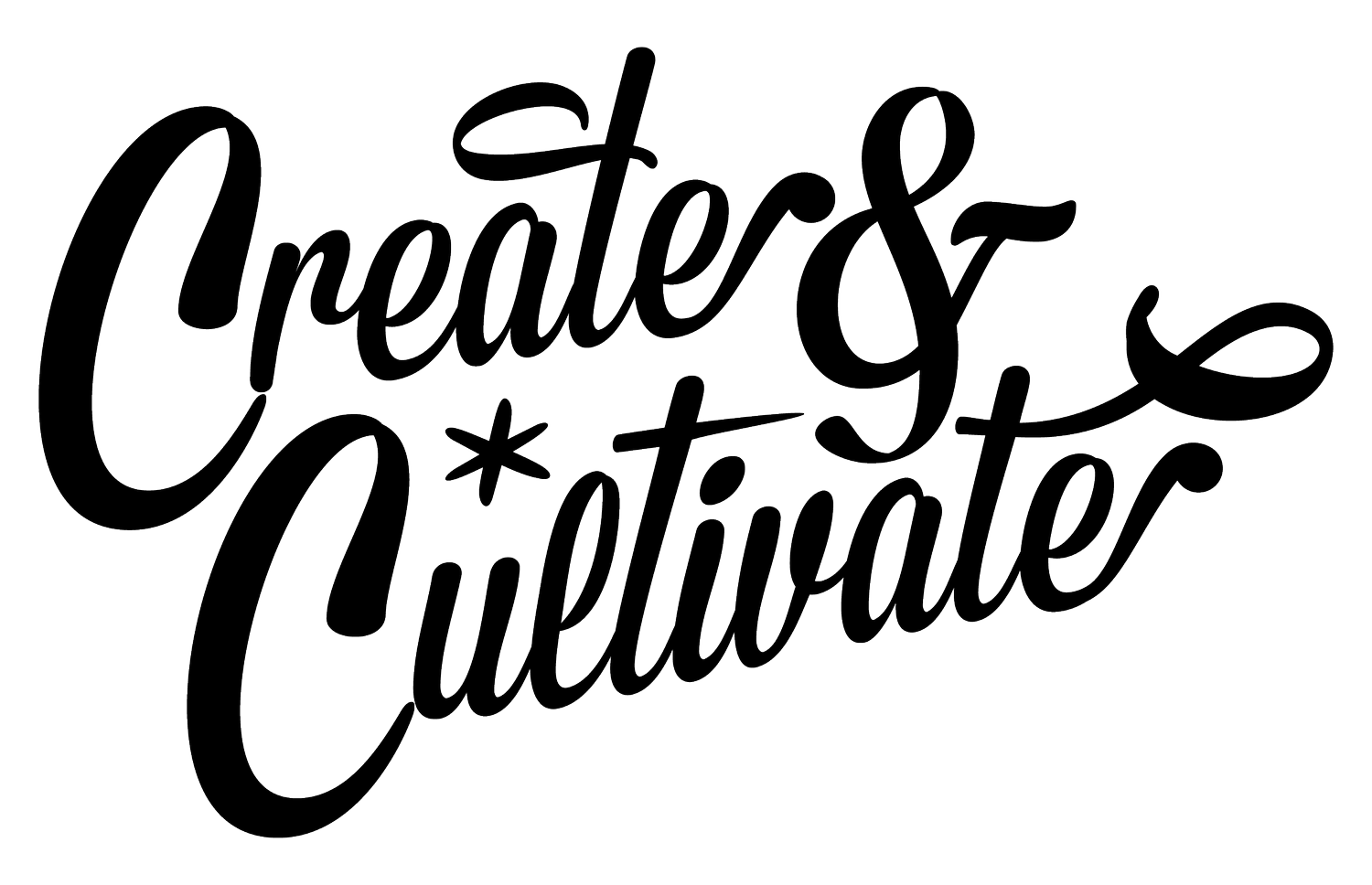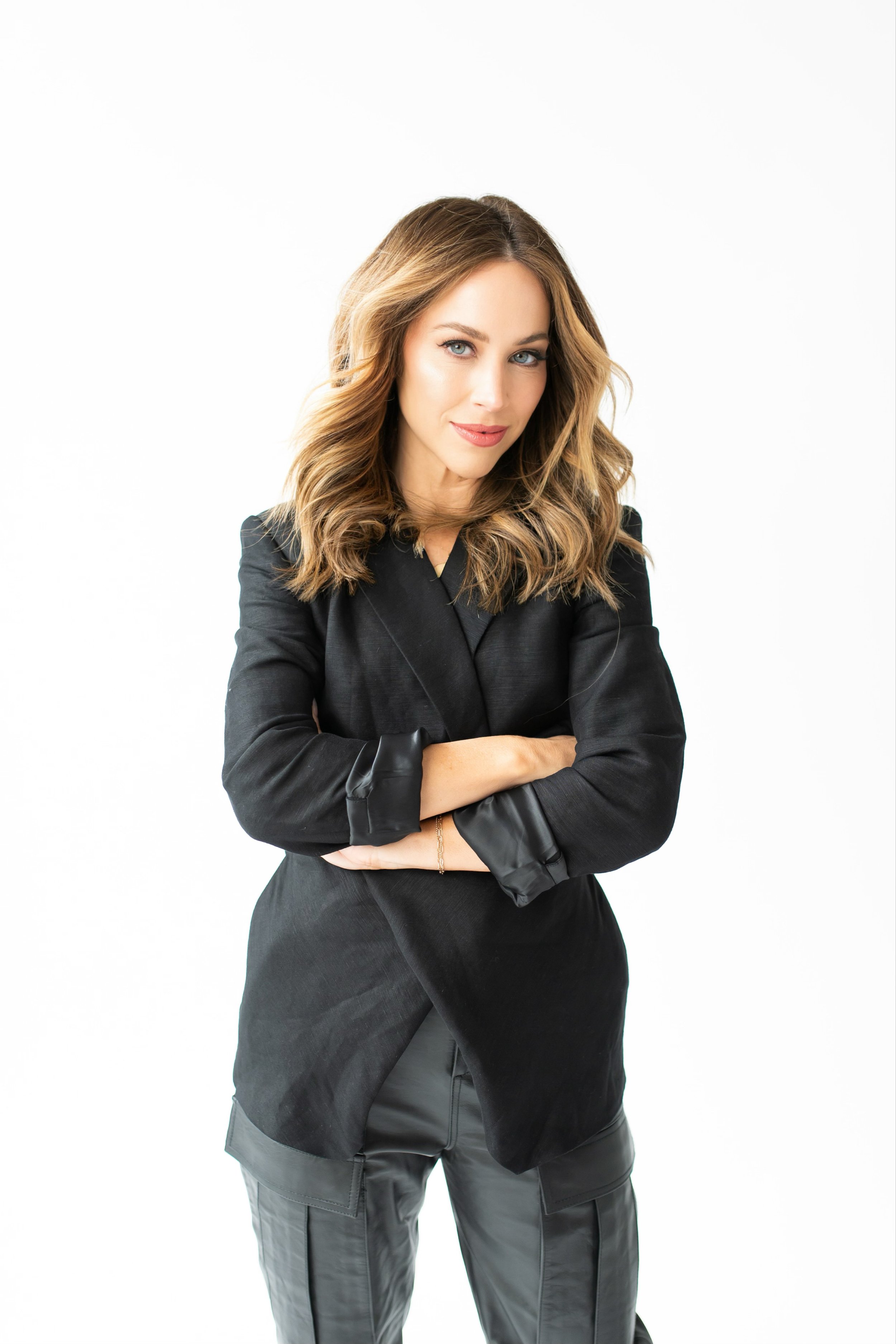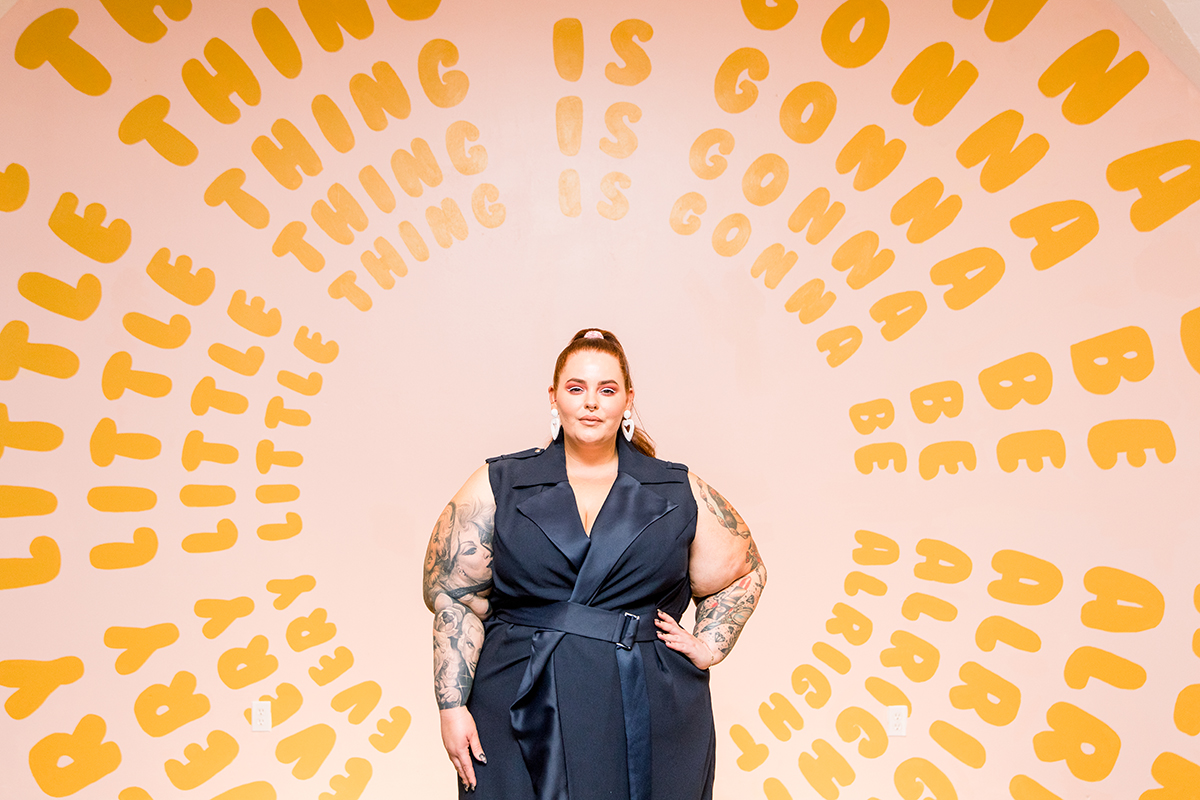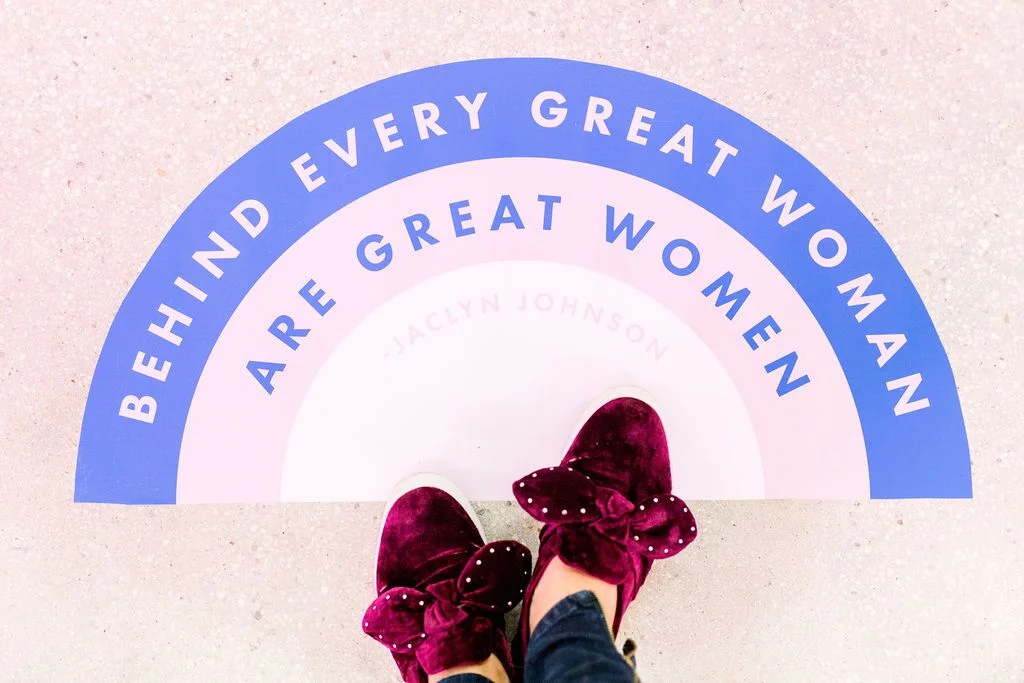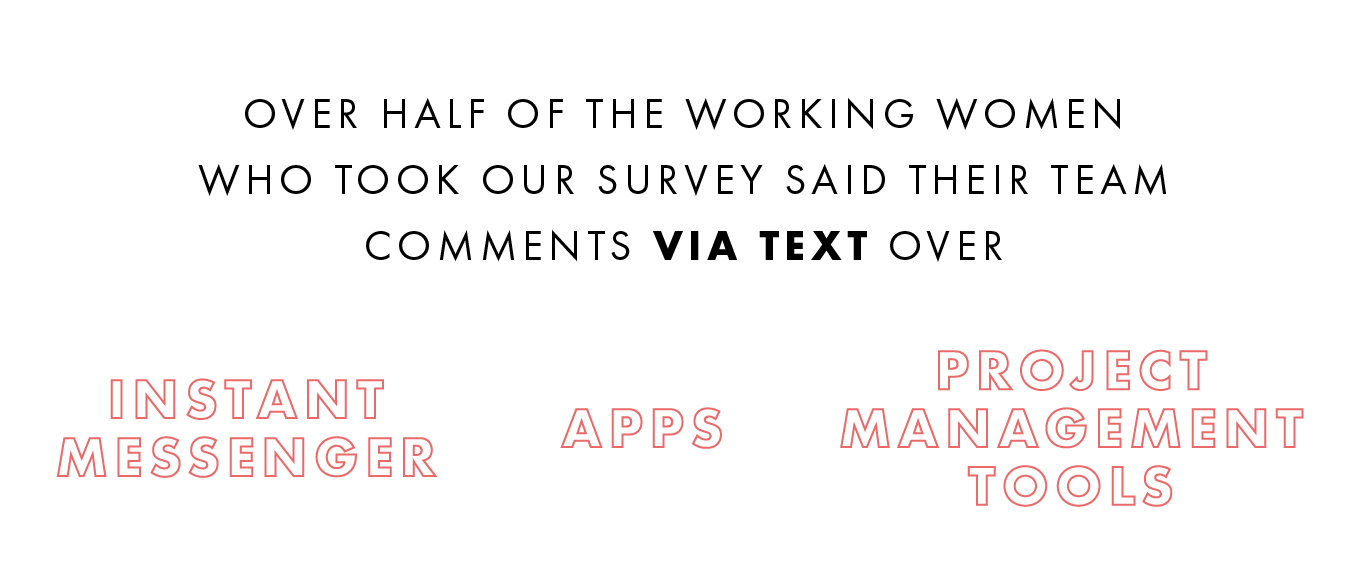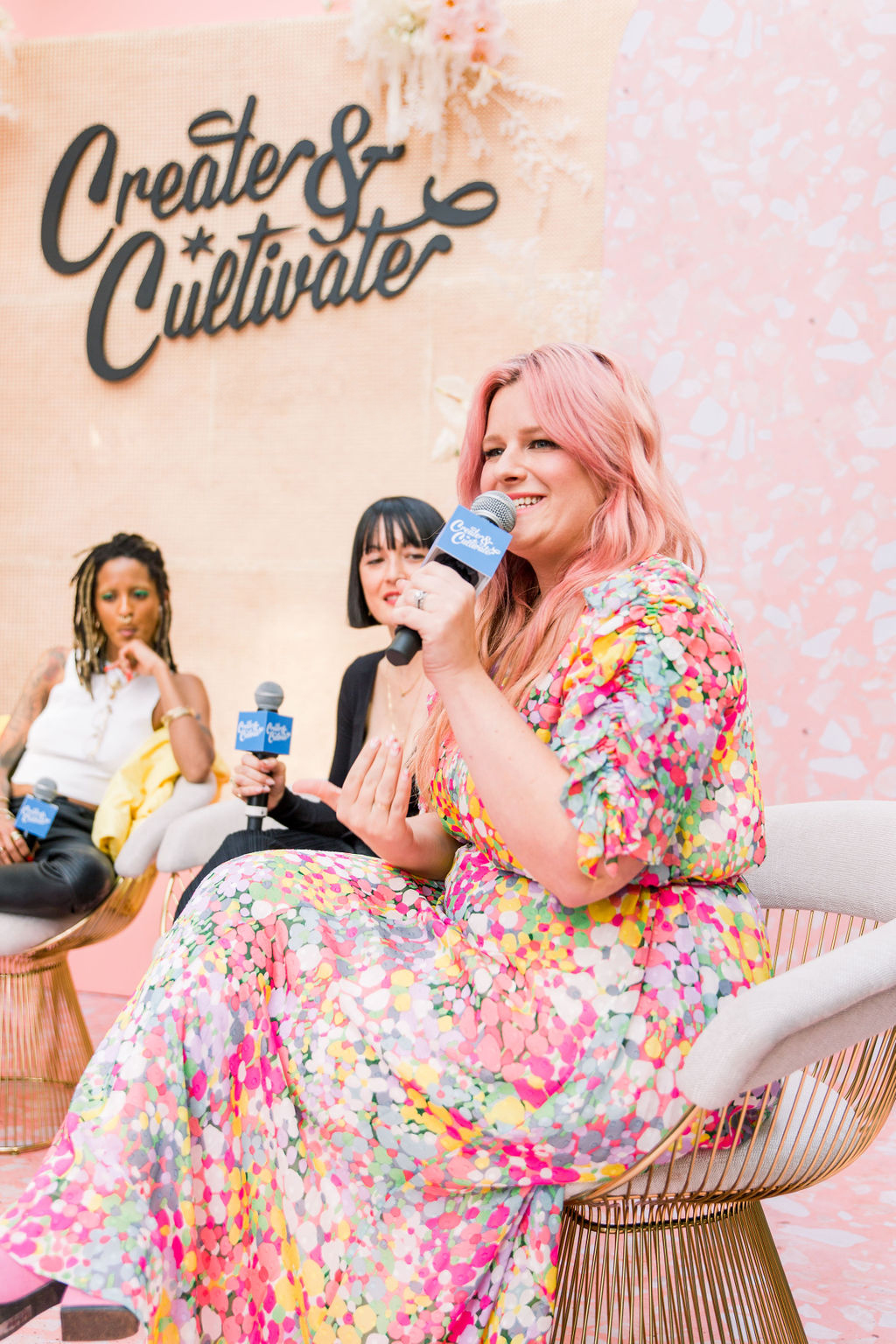Easy Money: How to Afford the Life You Want (Even If You Don't Have a 6-Figure Salary)
This app is a gamechanger.
This post is in partnership with YNAB.
Photo: Courtesy of Create & Cultivate
Are you familiar with the phrase “scroll head”? If not, here’s some slang 101: a scroll head is someone that aimlessly scrolls through social media, with no purpose at all. In the tech-driven world, we live in, it’s common to find ourselves subconsciously using apps that provide us with no beneficial outcome.
Some jaw-dropping data we found courtesy of Pew Research Center states that 81% of Americans own a smartphone and users between the ages of 18 to 29 are the most dependent on their devices. No real surprises there, but our question is, what are those young adults doing on their phones? Some likely guesses are scrolling through Instagram or texting their group chat. But what about budgeting their monthly income? Say, what? Well, after reading a recent survey that found most young millennials had less than $1,000 in their savings accounts—nearly half had nothing saved at all—we can only hope that they’re devoting some of that scroll time to getting their finances in order.
So, if this sounds like you and you haven’t yet implemented a money-saving strategy, then it’s high time you did. And for those who already have one (and want to up their game), this will interest you, too. Introducing the app that consciously sets you up for success—You Need A Budget (or YNAB for short).
Whether it’s a European vacation you’ve been postponing since graduation, a little more spending money to support your social life, or you simply want to start saving for the future—you need a budget. And it’s no mystery that budgeting can be a big monster to tackle. But, thankfully, YNAB is here to be your best money-saving friend and help you get to where you want to be, financially. It’s so easy.
To make matters even easier, we’re going to show you a break down of the YNAB app’s features with a visual guide below. Follow along to see why you need a budget (like right now!).
Be sure to read all the way to the end to take advantage of YNAB’s special offer for Create & Cultivater’s!
How to budget with YNAB:
We created a theoretical monthly budget for someone who would benefit greatly from YNAB. This person is a freelancer, who brings home $4,000 (after taxes) per month. With the rise of the gig economy, it’s been made prevalent that freelancers facilitating multiple streams of revenue have a more convoluted experience when managing money. So, we wanted to highlight what that might look like, in a way that is easy and beneficial to any and all potential users—freelance or not.
Download:
When you download the app, you are given the option for a trial month free. Once that month is over, they will charge your card info stored in the app store at the yearly rate of $83.99 to continue using. Note: While, at first, this might seem like a steep price to pay for an app, we can guarantee you, that when you see how much money you’re saving (and how much this app is doing to streamline your finances) you’ll understand why. Think about it, that’s just $6.99 a month to have a financial advisor in your pocket. Believe us, it’s worth it.
Link or unlink:
You’ll be given the option to link your bank account directly to the app or manually input your dollar amount to then start budgeting. This is up to your discretion. For the sake of our theoretical monthly budget for a freelancer, we chose to manually input the take-home of $4,000.
Your accounts:
You will see a screen with a list of your accounts. You can choose to add multiple budget plans here. For our example, there is one account titled “Monthly Budget”.
Your budget map:
Your budgeted amount inputted (or the amount reflecting your current bank account balance if you decided to link your bank account) will be highlighted in green at the top of the screen. And below that, you will see a list of expenses you wish to budget against. Your budget map is completely customizable and it’s up to you how you choose to label and allocate your spendings.
Expense categories and labeling:
You can change the names of the different expense categories along with the expense names themselves. We added “Hopeful Savings”, renamed some expense labels, and removed other default expenses that came with the app.
Allocating your preferred spending:
You choose how much you want to allocate to each expense. Below is what we came up with for our theoretical budget. You can edit these allocations as you go if things change for you and your money. The app will let you know when you are over budget by showing the negative amount at the top and highlighting it in red.
Other features:
Beyond the budgeting tactics and tools, there is also a help button that will provide you with any assistance and resources you might need on your way to budgeting. You can also view your “Age of Money” to see how long as well as how much you have been saving. The “Net Worth” function shows what your debts and assets amount to and for more insight into your money-saving success. For more help, check out their online resources and guidelines.
Conclusion:
Though you will have to invest some time (approximately 20 minutes) to input all of the figures, in the beginning, it will be worth your while. Once the setup is complete, it’s easy money. In this specific scenario, savings came out to $140 a month. Now, this might not sound like a lot of bills. But think about it, over a course of 12 months, that’s $1,680. And remember, your budget map is always adjustable. We just placed higher importance on the money for fun and clothing, rather than bigger savings. But, that is just one scenario. After seeing how much we had leftover after dividing up our money (the way we thought we should), we came to realize that maybe we should reset our budget map and reconsider how much we want to save each month. This was a blatant sign of why we should save!
This theoretical process was purely to show the capabilities and functionality of the app. It’s literally that easy to map out your spending on a monthly scale, and incredibly helpful to see what you think you should be spending on rather than the reality. The app allows for extensive customization and we couldn’t love it any more than we already do.
Saving money is incredibly important for a number of reasons, but as is treating yourself here and there. There is no passing of judgment on what you spend your money on, and the app reflects that entirely. Now get out there and start budgeting and don’t forget to make adjustments along the way!
SPECIAL OFFER:
YNAB is giving all Create & Cultivater’s the chance to try the game-changing app for 34 days FREE of charge. So, break the paycheck to paycheck cycle, get out of debt, and save more money to reach your goals. It’s your turn!
Slow Stories—Literally, Slow Down: How Taking a Content Break Can Lead to Successful Storytelling
The turtle wins the race.
Photo: Courtesy of Slow Stories
Ahead of the season three launch of the Slow Stories podcast, I'm thrilled to return to our namesake column after a summer-long hiatus. When I wrote the most recent article in July, I was on the tail end of a period where I had essentially been operating on autopilot. Naturally, this ran counter to the idea of slow content and the themes that we explored last season on the podcast.
While my work certainly didn't stop this season, taking a brief pause from this particular initiative allowed me to recalibrate how I am able to fully implement a slower and more thoughtful approach to content across my personal and professional channels. As things kick into high gear for the upcoming fall/holiday content craze, I'm sharing a few things to think about if you're planning to rethink your content strategy during a high energy time.
Create Context
The most direct way to set the tone for a slowdown in content is to establish context as to why your audience can expect changes. This can range from a formal announcement outlining concrete details and timing of a content hiatus, or if you're unsure as to how long you need to recalibrate, subtle changes in your content calendar over an extended period. If you're a personality or individual content creator, I also encourage revisiting my April article, which also touches on the importance of boundaries. At the end of the day, whether you're a personal brand or business, it is at your discretion to decide how much you share online about the choices you're making within your company.
Adjust Your Posting Cadence
If you don't want to shock your followers with an unexpected silence, ease them to the changes by establishing a routine that is more in-line with your current content calendar. For instance, if you're in the middle of a visual rebrand and don't know how to incorporate this transition in your content, include elements that are reflective of your upcoming relaunch (i.e., inspiration imagery that contains colors from your brand color palette, behind-the-scenes creative imagery, etc.).
Or if it's a matter of the kind of content you want to step away from for a while, think about alternative ways to stay engaged with your audience. For example, if you are looking to step away from more highly-produced content, you don't have to stop publishing entirely. Instead, you can focus on "off the cusp" content geared towards mediums like Instagram Stories or Snapchat versus content that traditionally requires more planning on a blog, website, or Instagram feed.
Consider What a "Storytelling Sabbatical" Might Look Like
Regardless if you're in a marketing or content-focused role, creating content can be a full-time job in our current business landscape. Many modern companies have introduced sabbatical programs for tenured employees to take time off away from work and come back feeling recharged. The same thought-process is worth exploring in roles that require "always-on" responsibilities. While it would be challenging to step away from digital storytelling completely, if you are in a leadership position, consider implementing breakpoints that allow your team to immerse themselves in their field outside of the office.
Perhaps there is an opportunity to facilitate an offsite retreat or outing. For individual team members who may need to recharge, consider covering charges for a co-working space or an industry conference (like Create & Cultivate!) that will enable them to still add value to the company while also providing space for personal growth. The most compelling content and stories derive from innovative thinking. Sometimes all it takes is stepping back for a moment to inspire a considerable leap forward in the long run.
With the above points in mind, if you can take a content hiatus (either personal or professional) here are a few ways to maximize your time:
Regroup with Your Team or Collaborators
Whether you're in a corporate team or a solopreneur, storytelling is a collaborative effort. Use the time away from your devices to encourage face time to brainstorm and reconnect with those you work with closely.
Relaunch and Revise
When it comes to creating content with longevity, timing is crucial, so take the added time off to experiment and refine your content strategy, branding, or medium.
Redefine Your Definition of "Content"
Finally, think about how content exists in a modern landscape. Can events or experiences be content? Does content take shape in the form of a book or printed entity? Posing these questions will inspire new ways of thinking about how to disseminate your brand's story so that it keeps people on their toes while still connecting with in-the-know consumers.
These are just a few thought-starters to think about as you plan an upcoming content break and how to make the most of that precious time away from your screen. And if you need some inspiration during that time away, I encourage you to listen to the slow stories contributed by creative professionals in CONNECT(ED)ITORIAL's community.
I'll be back with my next article in October, but until then, check out these highlights from our season two podcast contributors:
Episode: Brandy Pham of PLANOLY on Creating Content with Purpose and Empathy
Opened by fashion illustrator Jeanette Getrost. Jeanette shares why The Florence Academy of Art Instagram page inspires her.
Opened by digital strategist and Written Coffee founder Ellie Eckert. Ellie shares why the book Applied Empathy resonated with her.
Opened by jewelry designer Grace Wong. Grace shares how Company of One speaks to what she's trying to do as a solo, small business owner.
Episode: Kathryn Duryea of Year & Day on Fostering Vision, Values, and Enduring Stories
Opened by Michelle Toney, co-founder of Morrow Soft Goods. Michelle shares a couple of books that have inspired her to slow down and lean into her imagination.
Episode: Carolyn Witte of Tia on How Content Can Shape How We Think About Modern Healthcare
Opened by Matisse Bustos-Hawkes, founder of Otro Lado Communications. Matisse shares why a podcast snippet featuring Sabrina Hersi Issa inspired her.
Episode: Alisha Ramos of Girls' Night In on Storytelling That Inspires Self-Care
Opened by Erin Allweiss, co-founder of No. 29. Erin reflects on two notable talks that resonated with her at the TED Conference.
Episode: Michael Ventura of Sub Rosa on Applying Empathy in Business and Storytelling
Opened by Veronica Souza of Vero Branding. Veronica shares why rediscovering a manifesto from her favorite cookbook reinvigorated her to slow down.
Episode: Tanya Taylor on Slow Content, Sustainable Style, and Standing up for Women Everywhere
Opened by Avery Cox, an interior designer. Avery shares why a compelling photography series by Anna Boyiazis inspired her.
To learn more about what slow content means and what it can mean to you, check out my first column here.
ABOUT THE AUTHOR:
Rachel Schwartzmann is the Founder and CEO of The Style Line LLC. She created The Style Line in late January 2011 via Tumblr and has fostered The Style Line’s brand in its growth since then. Rachel has been featured in esteemed sources including Forbes, Refinery29, and MyDomaine and has also spoken at Create & Cultivate and Columbia University on establishing a unique brand point of view and entrepreneurship. On October 1, 2015, Rachel took The Style Line in a new direction as a boutique content company with the introduction of its slow content agency CONNECT(ED)ITORIAL.
You can follow Rachel at:
The Style Line: @thestyleline (Instagram, Facebook, Twitter)
CONNECT(ED)ITORIAL: @connecteditorial (Instagram)
Rachel Schwartzmann: @rachelschwartzmann (Instagram) @RMSchwartzmann (Twitter)
Day in the Life: A Freelance Publicist Shares What It's Really Like to Go Out on Your Own
Truth bombs this way.
Ever wondered what people do at work? If you’re a voyeur like us, then you’ll love our series A Day in the Life where we get a real behind-the-scenes glimpse into the professional lives of CEOs, business owners, and entrepreneurs we admire. From their morning routine to the rituals that set them up for success and questions such as “do you ever reach inbox zero?” because we all want to know how to streamline our lives.
“Most of my daily activities are intentional, which makes me feel in control (like a real boss).”
—Kamari Chelsea
Photo: Courtesy of Kamari Chelsea
Confession: Sometimes I scroll through my own Instagram page (when I’m fighting late-night insomnia) and I reflect on old memories and how far I’ve come. When I scroll back to May 2016, I’m surprisingly nostalgic for the then 30-year-old me, staring away from the camera with bright-eyed expectation perched on a violet velvet couch inside the Mondrian Hotel lobby, Los Angeles.
The real context of that moment was even more alluring. In only a few minutes, I would be whisked away in an Uber to attend my first-ever Create & Cultivate conference. I envisioned myself rubbing shoulders with badass founders like Jaclyn Johnson and hearing megastars like Jessica Alba and Rachel Zoe share the secrets to building a wildly profitable yet chic business.
Needless to say, I was not disappointed by my experience (the VIP gift bag full of beauty products was a cherry on top of a surreal day). In fact, I attended the next two subsequent conferences in Atlanta and New York, soaking up all the business advice I could possibly get. It was a millennial pink whirlwind of networking, knowledge, and endless perks. By the end of a year, I was on a complete high.
As all highs do, though, mine slowly dissipated when I found myself sitting back at a desk job in late 2017, depressed because I had no idea how to create my own entrepreneurial lifestyle. I also had no perception of what that lifestyle actually looked like. Between the Insta-glam moments and breath-of-fresh-air conferences, I thought to myself, What does it actually take?
To answer the questions I once had—and to give an insider’s POV for those reading this who are also asking similar questions—I’m going to break down what my day-to-day life looks like now, three years into my journey. Since then, I’ve signed three major communications consulting clients, took a leadership role at a non-profit, and got married!
While this may feel far off for you, take a glimpse at what it takes, and you may realize in only a few steps, you’ll be on your way, too.
7:00 AM: Wake at Your Own Pace!
Listen, most business owners rave about waking up between 4:00 AM and 5:00 AM to take on the day. So, I’ll be brutally honest: No freaking way!
Unless I have a flight to Los Angeles or a train to New York (in which case, consider this quick tip: always travel early AF in the morning, so you can have a full day in the city you’re arriving in), I try to stay in bed with my husband until at least 7:00 AM. That means more time to playfully nudge each other and whine about who is taking up more space or comforters. There’s true value in being someone who gets eight hours of sleep a night; the benefits show up in everything from your skin to your attitude. I’ve learned to listen to my body and not what other people do, and it’s worked out gloriously for me.
So by 7:00 AM, I get up and give myself two full hours of peace. I try to leave the house within 25 minutes of waking up to go for a nice long walk in a local park. The fresh air, music (I play Jhéne Aiko on my headphones because she’s so pleasant in the morning), and the time spent moving slowly and intentionally is a luxury I won’t take for granted. It also allows my body to fully wake up on its own.
Ok, well, coffee also helps, so I religiously dash into the Starbucks by the park before heading home to shower and prep for the day. Basic, I know. So sorry.
9:30 AM: Finances, First!
Now it’s time to get down to business. I start with the most important thing: my finances. I recently hosted Kristin Lee, a celebrity financial planner, on my podcast and she emphasized the importance of checking your accounts and actually looking at your money. Literally everyone, with every size bank account, from Kylie Jenner to a 21-year-old intern, should be checking their accounts regularly.
I do just that. I review my personal and business bank accounts one-by-one, every day. This even includes my savings and stocks. Mainly, I do this to ensure there are no major surprises (the more you invest, though, the more you’re inclined to sometimes see good surprises like dividends).
Then, I review my business books. I start by opening up my accounting software, to ensure I don’t have any outstanding invoices or invoices that need to be sent to existing clients. Then, I check the ratio between my business expenses and my business income. This will help me keep a pulse on whether I should cut costs, pursue more client work, or set aside more money for quarterly taxes.
For some people, books can be boring; trust me, I used to be “some people.” Today, I’ve learned that a little pump-you-up music (Megan Thee Stallion, anyone?) plus some financial moments to look forward to (again: dividends!) can actually make this part of the day fun.
10:30 AM: Emails; I Make My Own Rules!
Once the money is squared away, I dive head-first into emails for legitimately two-and-a-half whopping hours. Since I work in PR and media, a lot of my time is spent pitching. I pitch partnerships; I pitch stories; I pitch for new business; I pitch potential podcast guests… I’m a pitching machine.
To be clear, “pitching” is a fancy way of saying “selling.” Any entrepreneur will tell you that selling is essentially the key to a successful business. You always need to be on your toes, making a sale and connecting people to what they need.
Inbox zero is not a goal (remember, I try not to do things just because other people do it). Instead, I pride myself in making sure I have at least five opportunities (pitches) going out every day, and five opportunities coming in. In my book, an opportunity can be anything from someone wanting to have a coffee date to an offer to be a guest on a new podcast.
Setting an email rule that makes sense for me and my goals is one of the best things I’ve done in my business.
“Inbox zero is not a goal.”
—Kamari Chelsea
1:00 PM—6:00 PM: Meetings, Meetings, More Meetings, and Surprise Meetings!
By 1:00 PM ET, I’m geared up and ready to relinquish my day to the whims of others. The minutes leading up to 1:00 pm are usually like the nerve-racking few seconds one feels when they’re riding a rollercoaster and it’s creeping up toward the edge of the tracks, begging to careen over into topsy-turvy mayhem.
Ok, maybe that’s dramatic, but I usually need to take 10 minutes to exhale (or inhale a salad) before the day of meetings begins. Most of my clients are on the West Coast, while I’m in the East, so having my mornings to myself is a God-send. However, this is the moment when everyone is wide awake, caffeinated, and working, which means… I am up to my ears in meetings, calls, and surprise issues.
6:00 PM: Networking: Required for Entrepreneurs!
By “quitting time” on the East Coast, I’m technically still knee-deep in meetings. However, by this time, I’m rolling into a different type of meeting.
I exclusively block off evenings in my calendar for networking meetings. The only way to grow a business and keep new opportunities in your inbox is to nurture your network. That’s why I try to take at least four nights a week to meet up with someone in my professional circle.
These meetings can include anyone from media to mentors and mentees, to cold-invites I send to people I really want to get to know. Actively networking (which is really just fancy language for “making new friends”) has become one of the most foundational building blocks of my business.
If you’re just starting out, begin by setting aside four hours a week to meet new people in your industry. Plus, it doesn’t hurt to have an excuse to go out for a drink or appetizers in new spots around your city.
“The only way to grow a business and keep new opportunities in your inbox is to nurture your network.”
—Kamari Chelsea
8:30 PM: Dinner and Educational Leisure: A Book, Documentary, or Course
While the day is far from over, by 8:30 PM most of my clients are winding down, which means I can finally leave my phone in my bag for more than five minutes at a time. Since I try to commit one day on the weekend to being completely work-free, I maximize my evenings to do more work-adjacent activities.
The biggest myth of being an entrepreneur is that once you work for yourself, you’re completely free from anyone’s demands. But the truth is, the most successful entrepreneurs demand a lot of themselves.
For me, that means whipping up a 30-minute healthy dinner for me and my husband (vegan tacos are my specialty). And immediately after eating, I kick my feet up to crack open a new business book (right now, it’s Ted Talks by Chris Anderson), turn on a documentary (my current fave is Netflix’s The Black Godfather), or catch up on an advanced-skills course (today, I’m learning more about Facebook ad-buying).
Overall, it can sound like a gruesome day, but most of my daily activities are intentional, which makes me feel in control (like a real boss). My routine is a result of years of trial-and-error (no, I can’t wake up early to save my life; yes, I can eat healthier). It’s also centered on doing what is right for my unique business.
So, the real lesson is, once you know what industry you want to go into, get out there and network and then build your time around the goals that matter most to you. Before you know it, you’ll be building something of your own.
About the Author
Kamari Chelsea Guthrie is a multi-hyphenate media consultant, specializing in PR and content creation. Past and present clients include Coca-Cola, Parkwood Entertainment, Vote.org, DJ Spinderella, and TheKnot. She is also the host of The Truth Report podcast. Find her on Instagram @kamarichelsea.
A Day in the Life: The C&C Photographer, Becki Smith on Routines, Founder Depression, and the Inbox Zero Myth
“Always be open to the pivot.”
Ever wondered what people do at work? If you’re a voyeur like us, then you’ll love our series A Day in the Life where we get a real behind-the-scenes glimpse into the professional lives of CEOs, business owners, and entrepreneurs we admire. From their morning routine to the rituals that set them up for success and questions such as “do you ever reach inbox zero?” because we all want to know how to streamline our lives.
“Always be open to the pivot. If I had been hellbent determined to stay on the same path forever, I would absolutely not be where I am now.”
Photo: Courtesy of Smith House Photo
There’s something incredibly special about Becki Smith. Her eye has captured hundreds of images at our Create & Cultivate events and despite the organized chaos behind-the-scenes, she is always the grounded, enigmatic, effervescent girl who smiles the widest through it all—and that energy goes straight into every single capture. You can almost feel it when you look at them. It’s Smith’s gift.
But the founder of Smith House Photo wasn’t always a professional photographer by trade. One day, Smith quit her corporate job to see if “I could make this photography thing work” but she didn’t know that one day she would eventually be shooting for C&C, shooting weddings, and for major brands like Chandon. Smith just took the leap and hoped that her feet would find solid ground eventually. It’s safe to say, she has landed safely and is now leading a very successful business—with more exciting projects launching soon—shhh!
So, we took five with Smith recently to get a behind-the-scenes glimpse into the day in the life of a photographer. She was incredibly candid sharing her experience with founder depression, her typical routine, and why she believes inbox zero is a myth. Read on!
Photo: Courtesy of Smith House Photo
What does an average day in your life look like?
I have never been particularly great at routines and I get bored fairly easily, which is why being a photographer and business owner is the best fit for me as a career. Every day is different. Whether it is a shoot day, an event day, an office day, or an off day, I get to work in so many different roles, stretch my creative muscles, learn something new constantly, and explore places and people I never could have imagined. But no matter what, every single day includes coffee (usually an Americano or a coconut milk latte), my skincare routine (because in addition to wanting to have great skin as I get older, it is incredibly relaxing), and puppy snuggles.
What time do you get up? What’s the first thing you do upon waking?
I have an alarm that goes off every day at 7:30 am. It is a “hey its morning!” kind of alarm. Sometimes I wake up and make breakfast, sometimes I lay in bed and read for a little while, sometimes I go for an early walk with the pups. It really just depends on the day and the calendar or to-do list for the day. The one thing I don’t do (as hard as it is) is check my email—Jaclyn Johnson also follows this rule. I have to give myself time to get moving and caffeinated in the morning before I dive into the inbox. It is life changing and mood changing. I highly recommend it.
Are you a night owl or a morning person? When do you do your most important work and why?
For as long as I can remember I have been a night owl. But as I get closer to wanting to start a family I have tried to make adjustments so I don’t work deep into the evening (and evening is generous because if I’m being honest, it was deep into the dark morning hours). I read the book The Power of When earlier this year and it helped me to figure out my most productive hours are actually around 2 pm to 5 pm, so I make the most of these hours by getting organized in the morning so I am ready to run during those peak times.
“I went down a deep path of depression when this loneliness first set in because I was certain I had a job that would bring me joy. Everyone was always telling me I should feel ‘so lucky’ to pursue my passion and work from home but it didn’t seem so lucky, and it didn’t always bring me joy.”
Photo: Courtesy of Smith House Photo
Being a founder means you are wearing so many hats and across so many facets of the business. How do you manage your time effectively?
Time management? What’s that? I kid, I kid but this is definitely not my strongest suit. The best thing I have done for my own time management is to hire and outsource. I did an audit of all of my tasks, which ones I excelled at and which ones only I could do. Then looked at the other side of what were my pain points and what caused the most stop in my workflows. What could other people do as well, if not better than, me? And then I surrounded myself with people to fill in those tasks—and they are rockstars.
Do you ever reach inbox zero? How do you handle the constant influx of inquiries and communication entrepreneurs are so familiar with?
Oh, inbox zero. I used to think of that as a huge goal, but I realized it is truly a false hope. If I am actively working with clients, or getting inquiries for new work, I don’t actually want my inbox to be at zero. So instead, I make it a goal to keep my inbox cleaned up and organized so that I don’t miss anything and aim to respond to all emails within 48 hours. I still fail at this sometimes—usually on the days where there are 100+ new emails or I have been shooting/out of the office for multiple days in a row.
My saving grace is to always be honest. Own up and apologize when you miss an email or take too long to respond. We’re all human, we all do it, and the person on the other end of the email is much more likely to respond favorably and with kindness if you own your mistake instead of trying to cover it up.
What are some work habits that help you stay healthy, productive, and on track to reach your goals?
Staying healthy is not talked about nearly enough in our entrepreneurship and “hustle” world, but it is so important. I struggle with anxiety, and it flares up the most when I’m not taking care of myself. So, no matter what is going on or how busy I am, I give myself time to rest and time to walk with my dogs. Both of these things stave off anxiety for me, which enables me to stay on track with my goals. I am better off being behind and needing to outsource something extra for the month than being exhausted, lethargic, and anxious.
Keeping this time for myself is also helpful in saying no to projects or clients who aren’t the right fit, and setting future goals. I am constantly learning how much space and time I need, how many projects I can handle simultaneously, etc. So rather than just aiming for more, I am able to set new goals that steer me in the direction I want to go and ensure I have ample time and energy to follow them through.
Photo: Smith House Photo
When do you go to bed? What’s your “optimal” # of sleep hours?
Oh, sleep, how I love thee. The only thing in the world I love more is my dogs. I was very guilty of having no work life balance for the first few years of my business. As I get closer to starting a family I have given myself boundaries, which includes cutting off the computer in the evenings so that I can actually go to bed at a decent hour. (I’ll say, cutting off the computer about 95% of the time, because deadlines, am I right?)
On a regular basis I need a solid eight hours. During event or large shoot weeks, I actually struggle to sleep more than five or six from pure excitement. But when I come home from such weeks, I typically have a 12 to 14 hour sleep night to make up for all of it at once—14 hours sounds crazy, and it totally is, but when your body needs it, it needs it!
What’s the most rewarding part of your day?
Recently someone described me as “the girl next door who works her ass off so that she can stay home and snuggle her dogs” and it is so true. The most rewarding part of any day is when I can come home knowing that I have worked incredibly hard to serve and love my clients and my team well, crash on the couch, and snuggle my pups.
When did you know you wanted to start your own company/brand? What was your journey like? What challenges did you face along the way?
I recently shared about my “Tequila and Two Weeks Notice” story on Instagram. But even after I decided that I wanted to quit my corporate job to see if I could make this photography thing work, I didn’t know that I wanted to start my own company. And I probably didn’t even know what a brand was for a little while. I was just picking up my camera and trying to convince whoever I could to get in front of it. This turned into inquiries and booking paid jobs.
My journey was all over the place; I have photographed families, babies, dogs, weddings, furniture… anything you can imagine. It took me about two years into my journey to really dive into branding, and I don’t think that was a bad thing. I knew more about myself, what I loved, what work I wanted to pursue long term, and who I was as a photographer and business owner by this point which made the branding process so much easier to go through.
What advice do you have for aspiring female founders/entrepreneurs?
Always be open to the pivot. If I had been hellbent determined to stay on the same path forever, I would absolutely not be where I am now. I was given the opportunity to work with a handful of small, local brands when everything else I was shooting was specifically couples and weddings. If I had said “this isn’t my lane, I can’t do it” I would have never gained more commercial and event work, which I have learned is truly what sets my heart on fire.
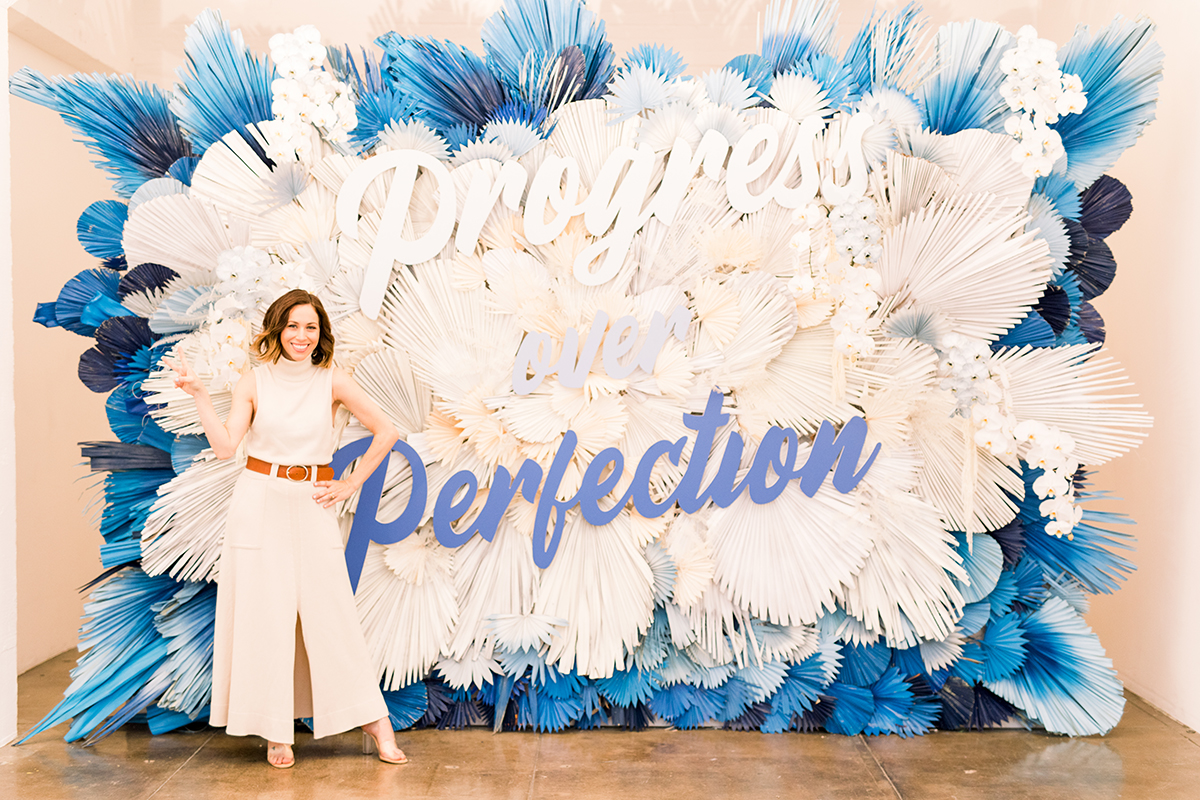
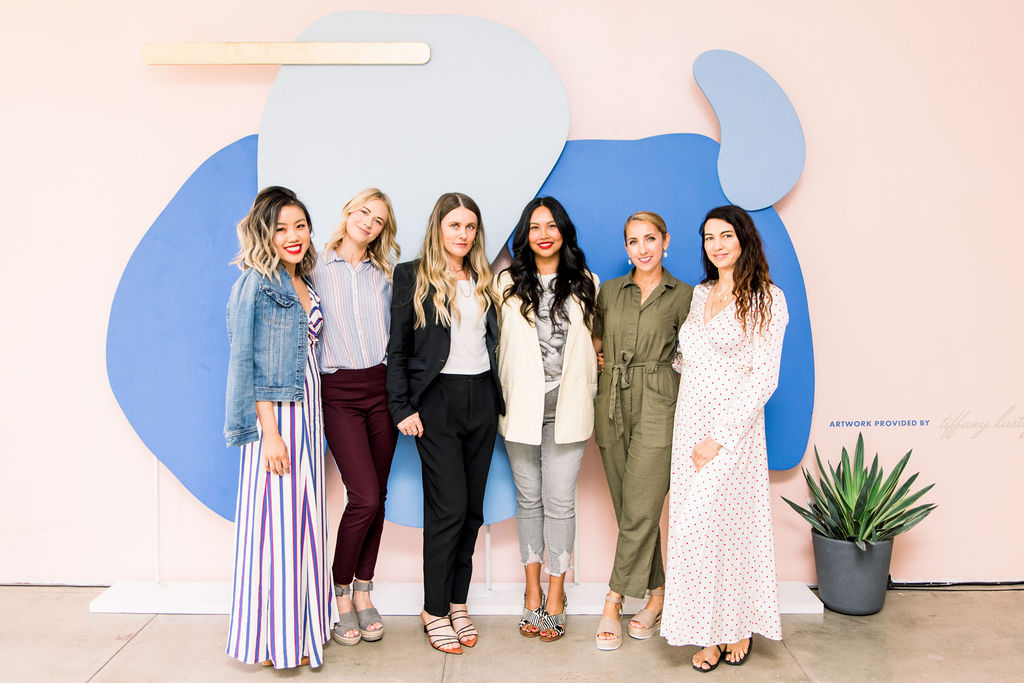
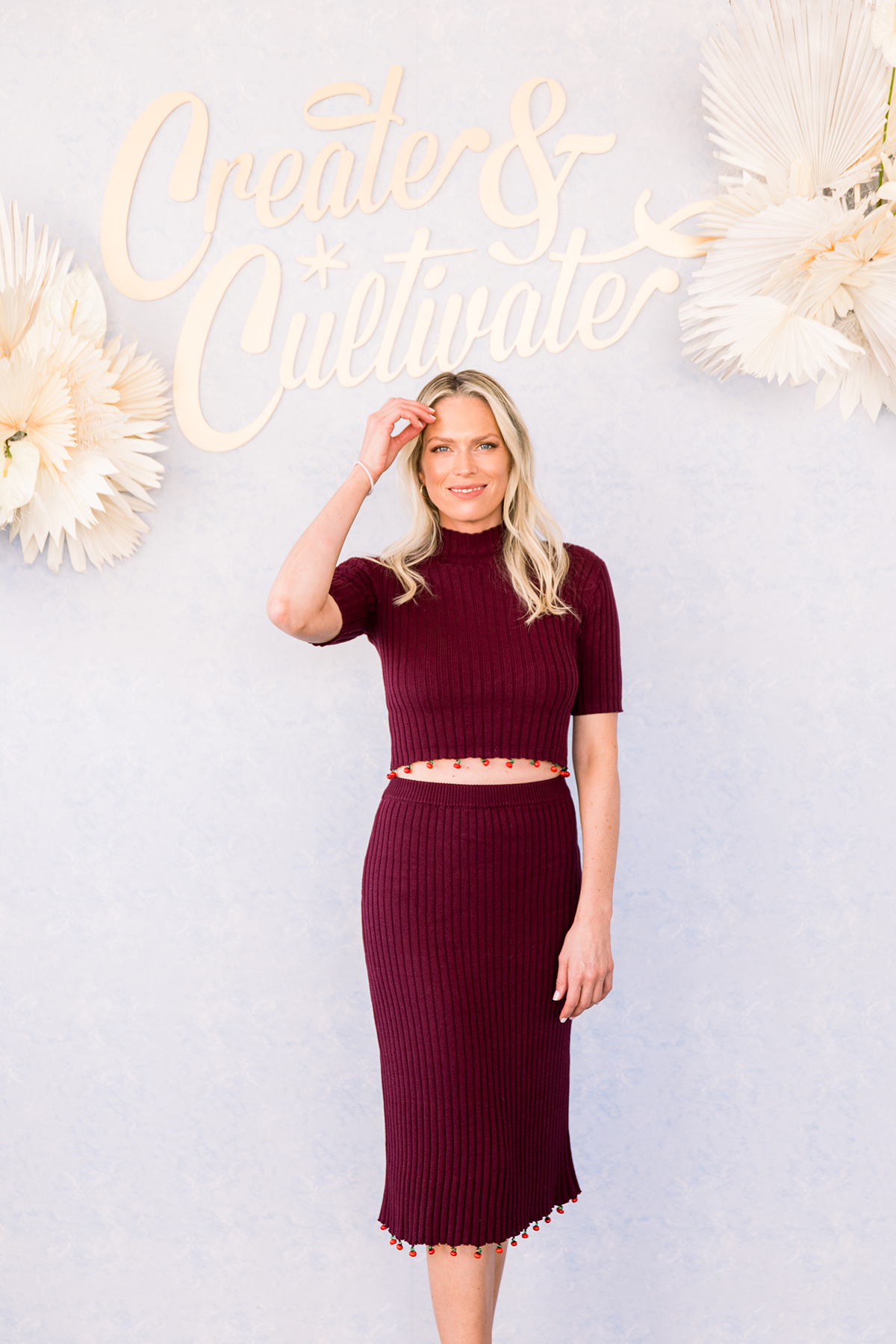


How do you combat the loneliness often felt by women at the top or branching out on their own?
It may be a cliche sentence, but the struggle is real. Starting off as a solopreneur was hard especially after working with coworkers and in fast-moving environments. I went down a deep path of depression when this loneliness first set in because I was certain I had a job that would bring me joy. Everyone was telling me I should feel so lucky to pursue my passion and work from home but it didn’t seem so lucky, and it didn’t always bring me joy.
After some soul searching, lots of therapy, and realizing that I wasn’t the only person that felt this way, I was able put a network into place of other photographers, business owners, etc. that could be my “remote” co-workers; they were just a phone call away, or a coffee shop date down the road, when I needed someone to lean on.
Now I have a small team, but they are all remote and freelancers. So there is still the work from home loneliness sometimes, but I have coping mechanisms and a great support system, so it doesn’t have nearly the affect that it used to.
What’s the best piece of advice you’ve been given?
The best piece of advice I have ever been given was “Don’t be a Luke & Cat cover band”. Luke and Cat are fellow photographers and mentors of mine. They are incredible educators and are willing to tell all of their secrets and share all of their knowledge to bring up future photographers and build up the industry as a whole. But they give it all away with the advice that everyone should take the information and create their own brand, their own goals, their own journey because cover bands are never as successful as the real thing.
What’s the worst piece of advice you’ve been given?
There is far too much bad advice out there to narrow it down to a single worst piece. I am a person who believes you can learn something from anyone you meet. But you have to take information, opinions, and advice from people with a grain of salt. Whether it is a stranger in the grocery store who thinks they can tell you how to get new clients without knowing anything about you or your business, or a trusted colleague or mentor, you should always be weighing the advice. Say thank you, take it home, and then decide if it is worth listening to or dismissing.
What are some exciting projects you’re working on this month? What are you most excited for in 2019?
2019 has been a big year for Smith House Photo and we are just getting started. We have been working on a handful of long term projects (stay tuned!) that are launching in the next few months and the excitement is building up so strong that we are bound to pop like a bottle of Chandon once we get to shout it all from the mountains.
Up Next: A Day in the Life—Glitter Guide's Taylor Sterling Shares Her #1 Ritual for Success.
It's Here! Step Inside Our Chic (and Cool) Create & Cultivate Clubhouse in Los Angeles
Where all the magic happens.
Photo: Smith House Photo
Welcome to the Create & Cultivate Clubhouse! We’re so excited to finally reveal our new L.A. workspace where all the magic happens. C&C CEO, Jaclyn Johnson worked closely with interior designer Ginny Macdonald to create an office that not only reflects the unique vision, voice, and DNA of the C&C brand but also inspires and motivates its dynamic team. Ultimately, they wanted to create a collaborative working environment where people could work away from their desk or have smaller team meetings.
Designing every inch of the 5000-square-foot industrial-inspired space in downtown Los Angeles was no mean feet—the large open-plan office has a mezzanine level, three private offices, an open-plan kitchen, conference room, and two bathrooms—but as you can see, Johnson and Macdonald nailed it. The cool urban-industrial architecture style complete with exposed ceilings, double height black metal-framed windows, cinder block walls (painted white), and concrete floors was essentially a blank canvas for them both to put their stamp on.
The first thing people notice upon entering the space is the color scheme. For this, Macdonald really tapped into the Create & Cultivate DNA with salmony pinks and blush tones. “Jaclyn’s husband is a super talented artist so he created two amazing wall murals,” Macdonald recalls. “The first being the terrazzo inspired wall in the lounge area where he used a mix of different shades of pink, peach and gray from Dunn Edwards. The second mural is one of C&C’s mantra’s ‘Collaboration Over Competition’ which is such an inspiring quote so it had to be big and bold.”
Head over to Domino for the exclusive tour including Johnson’s morning routine, then scroll down to learn more about Macdonald’s design process—and shop the room!
The Kitchen





Macdonald considered swapping out the cabinets in the kitchen but it seemed “super wasteful” so she decided to work around them. “Black is such a good base color that goes with everything, especially pink,” she says. The designer stuck to three main colors—black pink, and gray—and added an 8’ long 4-sided waterfall island in a matte finish gray quartz with white veining.
“It looks absolutely incredible and adds a touch of drama in there,” she adds. “We also used the same material to swap out the countertops and added a pretty pink stacked glass tile from Fireclay for the backsplash. I’m so happy glass tiles are coming back because I love how light-reflecting they are.”
Shop the Room:
Dunn Edwards Translucent Silk Paint
Cambria Clareanne Quartz Island
Cedar & Moss Jane Brass Hardware
Cedar & Moss Bjorn Brass Drawer Pull
Joss & Main Darvone 1-Light LED Single Dome Pendant
e-Faucets Newport Brass Single Handle Pull-Down Spray Kitchen Faucet
e-Faucets Newport Brass East Linear Hot & Cold Water Dispenser
e-Faucets Kohler Riverby 33" Drop-In Kitchen Sink
Fireclay Tile Rosy Finch Gloss Tiles
IKEA Dinera 18-Piece Pink Dinnerware Set
The Reception
Photo: Smith House Photo
Macdonald was focused on creating pockets of space that went beyond just sitting at a desk all day. “We added two lounge areas and a few seating nooks where the girls can grab their laptops and hang out on a comfy sofa or take a call away from their desks to have a little privacy,” she says. “I love this pink reception area mainly because of the wall of patterned wallpaper. It’s a long and narrow space but we still managed to make two areas for people to work in—sofa or corner dining table. I would be super happy to sit in either of these rooms to take a break from my desk.”
Photo: Smith House Photo
“The general vibe is badass CEO.”
Macdonald partnered with CB2 to design Johnson’s office. “The general vibe is badass CEO and while we have our bright pops of color elsewhere, we kept this room feeling über sophisticated,” remarks Macdonald. To do this, Macdonald used a marble-topped dining table instead of a traditional desk to create a large work surface.



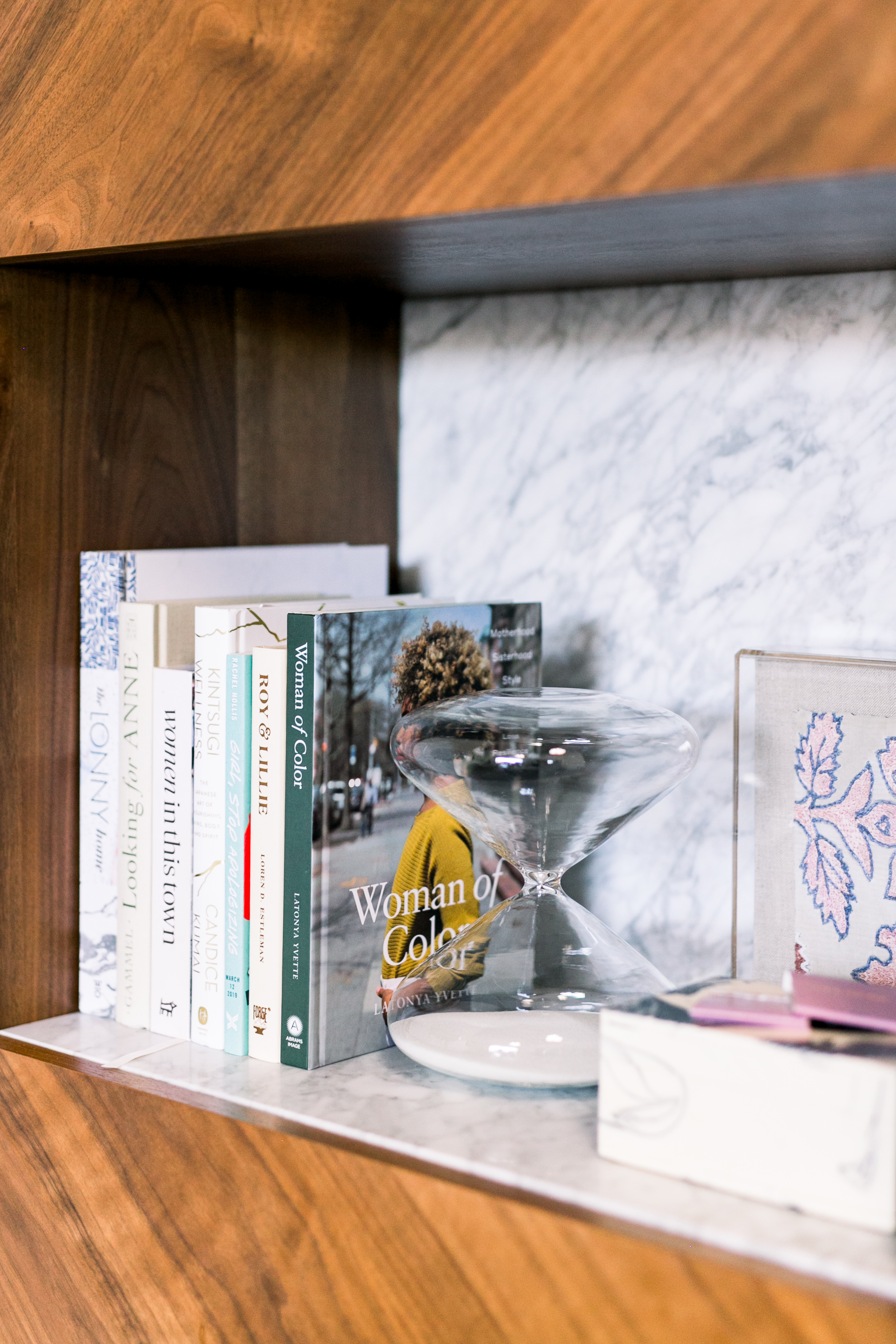
Macdonald then installed an oversized art piece on the back wall and flanked it with two tall wood storage pieces to add warmth and height. The plants on top of each unit also help to break up the symmetry and add some softness to the room.
Photo: Smith House Photo





Both Johnson and Macdonald wanted to capture the playful essence of the Create & Cultivate brand in the bullpen which is colorful, fun, and high energy but also elevated and chic. “The company is incredibly inspiring to women worldwide so we really wanted the space to represent that,” she explains.
The bullpen space is a long and narrow galley, so they really played into that when setting out the furniture. “We laid out the desks back-to-back in a long linear line which followed the elongation of the space,” she says. “Not only does this create a feeling of openness it allows for a collaborative and inspiring shared workspace.”
The goal was to keep this section really clean and simple since it takes up most of the space in the building. Everything is essentially white—all the desks, chairs, file cabinets and lighting—so the pops of color came from the pink lamp base and the blue pin board screens which they added to tie in with the “blue cave” at the back corner of the office.
Shop the Room:
Joss & Main Method Writing Desk
Joss & Main Villalba Table Lamp
The Container Store Blush Poppin Tape Dispenser & Stapler
RH Teen Classic Metal Frame Pinboard
The Lounge
“We tried to make this room feel like something you’d have in your own home.”
If she had to play favorites, Macdonald would put the lounge area at the top of her list. “Work and home life tends to really collide these days so having break-out spaces that don’t feel corporate and stuffy are really important,” she says. “That’s why we tried to make these feel like something you’d have in your own home.”
Since the lounge area floats in the middle of the space, they decided on a pink channel tufted velvet sofa which looks pretty when seen from all sides. They paired it with two rust toned crushed velvet side chairs with black frames to help edge it up a little. The coffee table—a heavy sculptured marble in an irregular organic shape—makes a cool statement piece and despite how physically heavy it is, Macdonald says it feels light in the space because of the color and shape.







Photo: Smith House Photo
The conference room was a challenge because they had to work with the existing black and gray carpet. “Since we were trying to be budget conscious we couldn’t swap it out and redo the concrete floors underneath, so instead we layered a brightly color rug on top to break it up,” she says. “This is a good tip for when you don’t love the floor finish you’re working with. We chose a rug that was bright but still had darker undertones so that it still worked with the carpet.” The light pink textured wallpaper on the walls also helped to soften the space and draw your eye away from the dark floor covering.
Shop the Room:
Joss & Main Carothers Dining Chair
Joss & Main Almazan Buffet Table
Joss & Main Asher 12-Light Sputnik Chandelier
Wallpaper Warehouse Lepore Blush Linen Wallpaper
CB2 Marcella Brass Antique Mirror Tray
The Blue Cave



Both Macdonald and Jaclyn are big fans of blue so they painted the walls in the office nook aka “The Blue Cave” in a deep navy hue. “This helps the space to feel grounded and it’s also a break from all the pink,” she laughs. This room feels aligned with Macdonald’s personal design style which draws on her U.K. roots or what she coins “rustic countryside style.” She loves to fuse the simplicity of the Scandinavian aesthetic with Japanese design. “I like a room to feel calm, cosy and fresh, well-put-together without being stuffy,” she says.
Shop the Room:
Joss & Main Fallon 4 Drawer Writing Desk
Dunn Edwards Summer Night Paint
Joss & Main Mid-Back Task Chair
Joss & Main Alden Etagere Bookcase
Joss & Main Asher 12-Light Sputnik Chandelier
Joss & Main Deegan 31" Table Lamp
Joss & Main Diamond Motif Zen Light Gray Area Rug
Framebridge Be Cool Man (Repeller) Print
The Bathrooms




While there were no major structural changes to the space they did make some small updates to the bathrooms including replacing the vanities and adding patterned wallpaper in each room. “We also swapped out all the overhead lighting for more modern fixtures that worked with our design,” she adds.
Shop the Room:
Joss & Main Caldwell 36" Single Bathroom Vanity Set
eFaucets Brizo Jason Wu Two-Handle Bathroom Faucet
eFaucets Kohler Purist Towel Bar
e-Faucets Kohler Purist Wall Mount Pivoting Toilet Paper Holder
Project 62 Round Decorative Wall Mirror Brass
Cedar & Moss Terra Surface Flush Mount
CB2 Lyle Round Vase
While this project is definitely a slight departure from the typical Ginny Macdonald Design style she really reveled in the challenge. “Not a lot of clients are wanting too much color at the moment,” she says. “They’re veering towards the all-white and natural California look (which kinda drives me nuts and we have to work extra hard to persuade them to stretch their boundaries) so it was really refreshing to get to use actual color in a space.”
To end this spectacular office tour, we want to leave you with Macdonald’s best piece of advice that applies to both decorating and life. “Trust your gut and dare to break the rules,” she says. “I try not to follow suggested formulas when it comes to decorating otherwise things can end up boring and no one wants that.” We couldn’t agree more.
"Make Your Own Waves"—How to Create a Brand (and Website) That Stands Out From Industry Voices
Do something different.
Even if you have a strong idea of who you are as a person, you can have a difficult time laying it all out on your website. It’s way too easy to get lost trying to imitate your favorite boss icons even though you already have an amazing personality and ideas that deserve to be seen. When I send out questionnaires to new clients, I often receive similar responses when I ask who they most admire for their writing. Many of my recent clients have been photographers who admire industry giants like Jenna Kutcher and Katelyn James, both of whom are known for their fun, personality-driven words.
It’s great to have role models, but too often we don’t look past those who we believe are setting the tone of our industry and realize that we can make waves of our own. When copywriting is a major part of building your personal brand, you have to stick the landing just right. The only way to accomplish this is to go through your own brand-building process to ensure that your words stand out in a competitive landscape.
Industry role models are awesome, but having your own voice is important if you really want to stand out. It may seem like one person is the tastemaker in an industry and that we should all follow that person, but why not try to do something different? Read on for four ways to make your brand and website stand out.
Tell your story.
When many solopreneurs dive into writing their website for the first time, they skip the all-important step of spelling out their offer, unearthing their core values, and surveying their ideal client. To really understand what needs to be on your website, you have to engage with your brand as an entity.
What do you envision for the future? How do you seek to help others? And why should your ideal clients be lining up around the block to work with you? This is also a great time to dig into your story and why you started your business in the first place. After all, every brand needs to have a point of difference. It’s likely you’ll find yours in your story.
The process may not look like everyone else’s, and this could also be what sets you apart. During this time, think about what you’re tired of seeing in your industry and what you wish you saw on other websites but have yet to discover.
Think about your ideal client.
When you’re fired up about an industry voice, it’s easy to get swept up in their brand so much so that you want to be exactly like them. It may seem like they are the only voice anyone would want to listen to. But think about it: You may love these industry voices, but does your ideal client? It’s possible and even likely that your ideal client may not resonate with the same people you do. Plus, even if your ideal client does admire them just as much as you do, isn’t it important to stand out?
The last thing you want to do is appear as if you’re imitating someone else. So take a little time to break down exactly why you like this industry voice. Is it because they are personality-driven, friendly, professional? Keep this tone in mind when you go to write your website but close the tabs with their pages so you can hear yourself think. When you go through the process of developing your messaging you can keep these adjectives in mind while writing but ultimately come to your own conclusions as to how you should write.
Walk through the user experience.
Too much of the time, we think of copy and design as separate entities but they’re really two different ends of the same process that leads to a cohesive brand and website. Which is why you should keep design in mind while writing copy.
Instead of trying to emulate someone else’s site, consider the main goal of your website. What do you want readers to take action on? Should they schedule a consult call or book their session? If they aren’t ready to buy from you, can they download a free guide or read your blog? Make sure your site offers something to the reader and make it extremely clear what you need the reader to act on so they can connect with you.
Not only will this make your site targeted to your ideal client but it will also be unique from others with different goals for their readers.
Get inspired.
If you’re still struggling to imagine writing differently from industry greats, it’s time to find yourself a larger pool of inspiration. Pinterest is a great resource for web design and copy inspiration if you just want ideas for your general aesthetic and style. It could give you ideas about how to lay out copy, configure your site, and place calls to action. But always remember that you should never imitate someone else’s site and always aim for uniqueness.
About the Author
Kayla Dean is a website copywriter and content writer for visual creatives helping entrepreneurs say what they mean with confidence and strategy. Her byline has appeared in publications like Bustle, The Believer, and Darling. When she’s not writing, you’ll find her planning her next big trip or marking a book as “currently reading” on Goodreads.
MORE ON THE BLOG
Know Your Worth—How to Calculate Your Hourly Rate As a Freelancer
Get that money.
When I started freelancing in 2014, determining my hourly rate was pretty daunting. What’s too high? What’s too low? Will this be enough to support my monthly bills? When someone has a full-time job, they’re given a salary that sets a financial road in place for raises, promotions and new positions ahead. When that person starts freelancing, a new road is set before them with a million different turns to take.
There’s an actual formula I recommend to anyone needing guidance in determining their rate as a freelancer. It starts by researching the salary you would ideally have if you were employed full-time for the services you look to provide your clients. For example, at the time this article was written the average national salary for a full-time marketing manager is around $80,000 according to glassdoor.com. If a person wants to freelance their marketing skills and is at a manager level in years of experience and general expertise, this is a good number for them to use for our freelance formula and it looks a little something like this.
From here, round that number to the nearest five. So in this case, the hourly rate is $85. Now that you have your hourly rate, it’s up to you to determine if that number will provide enough financial stability for your needs and the amount of hours you want to work. Whether you charge less or more is entirely up to you. You may charge less if you want to work with a client that has a smaller budget, or charge more if you specialize in a high-demand field of work. This formula is intended to give you a starting point to determine an hourly rate that is reflective of your value and what you can provide your clients with it.
Use the freelance hourly rate calculator to determine your hourly rate.
Another approach to freelancing is offering flat fees for routine services. For example, a graphic designer will more than likely be hired for designing repeat services like logos, business cards and social media headers. If that designer knows it takes an average of 10 hours to design a logo, they can use their hourly rate (let’s say it’s $45) to determine a flat fee of $450 for their logo design service and so on.
Also remember that as a self-employed person, you are responsible for taking out your own taxes, contributing to your own retirement plan and paying for health insurance. This is why we multiply by two to get our final rate. So if the number sounds higher than you anticipated, it’s for good reason.
By: Audrey Adair
Audrey Adair is a freelance communications consultant and founder of The Scope - a website providing resources and community for the self-employed. She had the idea for The Scope after about a hundred different people asked her the same exact question, “How do I do what you do?” With the freelance economy predicted to make up half of the total US workforce within the next decade, it's her goal to provide aspiring independent talent with the know-how and confidence to take on this burgeoning and in-demand industry.
This post was originally published on October 17, 2018, and has since been updated.
MORE FROM OUR BLOG
Mary-Kate and Ashley Olsen Built a Billion-Dollar Empire—Here's What We Learned
They don’t seem to put a stylish foot wrong.
In our eyes, the Olsen twins can do no wrong. From their iconic style we all want to mimic to their tenacious business acumen, the stylish duo haven’t put a (stylish) foot wrong since they launched Dualstar, at just 6 years old. Now, they’re building a billion-dollar empire that runs the gamut from fashion to fragrance with their brands Elizabeth and James and luxury line, The Row—arguably the Hermès of America. In 2011, their parent company, Dualstar recorded over $1 billion in sales.
On top of that success, they are also incredibly well respected in the fashion community, having won three CFDA awards. It's pretty clear that these stylish sisters know what they’re doing. But we want to know how? According to an interview with Vogue, the Olsens bought out the former owners of Dualstar when they turned 18 and took a break from acting to focus on the business. You might ask how they had the qualifications to run a billion-dollar company at such a young age, but as Mary-Kate quips, “Well, at that point we had been working eighteen years.” Fair point.
To glean a little more insight—and in honor of their birthday today—we read through some of favorite interviews with them (they’re notoriously shy so this required an internet deep dive) and pulled together their best business advice so you too can build a billion-dollar empire.
“We were always hard workers as kids. It’s just the way we are, the way we were raised. Our work ethic was everything, and that never left us. We like to work hard, and we like to try to do everything 100%. In fact, it’s actually almost impossible for us not to. Sometimes you succeed and sometimes not so much, but it’s learning.”
—Mary-Kate Olsen, as told to WWD.
“We’ve been exposed to so much. We were very fortunate to have parents and people around us who wanted us to be part of the creative meetings and the business meetings, and we would just sit and listen and be sponges. At that time in your life, you really are a sponge. And we’ve learned so much from people we’ve been exposed to in our lives—interesting people from different walks of life, different CEO’s. The list goes on and on. Mary-Kate and I have always taken advantage of our time with those people and walked away learning a thing or two.”
Ashley Olsen, as told to WWD.
“The thing about us is we think big. Huge.”
Mary-Kate Olsen, as told to Vogue.
“If you want things to be perfect or beautiful, it’s a lot of hard work. Nothing comes easy. That’s just the way we were raised; that’s what we believe is necessary to do something different.””
Mary-Kate Olsen, as told to British Vogue.
“I am not great at not being able to control the end product.”
Mary-Kate Olsen, as told to Allure.
“ It takes a lot of discipline but we’ve always been very driven, and we enjoy what we do. It’s what we know.”
Mary-Kate Olsen, as told to The Telegraph.
“We were always involved in the conversation. We worked so much that they wanted to make sure that we knew exactly what was happening and why—and our opinions mattered.”
Mary-Kate Olsen, as told to The Telegraph.
“It was about taking a step back and reflecting on our past, all the things that we’d learned, then deciding how we take all the knowledge that we have from the range of businesses that we’ve been in, and do it the way that we want to do it.”
Ashley Olsen, as told to The Telegraph.
“We didn’t want people to know that we were behind it. We had learned so much about building brands and talking to a specific customer. We did it with our faces at the beginning, and we knew we didn’t want to do that anymore. It’s far more fun this way.””
Ashley Olsen, as told to The Telegraph.
“Thank God our parents wanted us to be involved,” Ashley says. “Running a fashion company, it’s just as important to understand numbers as it is to have a design point of view.”
Mary-Kate Olsen, as told to Newsweek.
“We work as a team, side by side every day. At times it can get overwhelming, but at the end of the day, you care so much that you find the energy to keep going: Balance will always be a struggle.”
Mary-Kate Olsen, as told to MyDomaine.
““Don’t be afraid to take risks—well-informed risks.””
Ashley Olsen, as told to MyDomaine.
“No is a full sentence.”
Mary-Kate Olsen, as told to MyDomaine.
“I think we’re lucky [working hard] comes quite naturally for us. We don’t need so much time to sit and think and ponder. But then I have a husband, two step-kids and a life; I have to go home and cook dinner. I ride horses on the weekends. You find the thing that helps you relax and if you don’t have it, look for it. Or you get burned out and then you’re not productive.”
Mary-Kate Olsen, as told to Net-a-Porter.
“I’ve always been a worker. It has taken me a lot to figure out how to take a vacation.”
Ashley Olsen, as told to Net-a-Porter.
Collaboration Over Competition: How This Company Is Sharing Data to Make Driving Safer for All
We all know we’re stronger together than apart and this company is proving exactly that.
I grew up in a 1980 Volvo Coupe. It was large and in charge with a bold, bright red hue. Fast forward 20 years, and I would do anything to have that car again. Now more so than ever because I’ve learned about Volvo’s positive impact on the auto industry, and the values they’re inspiring all of us to believe in, too.
Volvo is a prime example of how “collaboration over competition” can be put into action for the greater good. We’re partnering with Volvo to share how this philosophy can be applied to every aspect of your life, whether or not you’re behind the driver’s seat.
Volvo Gave Away Their #1 Invention
It’s hard to believe that car safety used to be an afterthought. Now, we have cameras on our rear view mirrors and sensors telling us when we’re getting close to other cars. Driving has never been easier, some would argue, but it wasn’t always that way. Volvo was the first car manufacturer to care deeply about consumer safety. So much so that they “gave away the most important safety device ever invented: the three-point seat belt.” Car safety was forever changed because they believed that the best thing to do was to share their knowledge and collaborate on changing the way we drive today.
Building the Road Ahead—for Women
In March 2019, Volvo announced that they will share research on “crash-test safety with other automakers for free,” roughly 60 years after the three-point seat belts became standard in all cars. They continue to embody this idea of “collaboration over competition,” and are even making strides to specifically protect female car occupants. Volvo’s Project EVA, which stands for Equal Vehicles for All, aims to diversify test dummy sizes and designs, including people outside of average height and weight ranges that fare worse in car crashes. One of the ways Volvo has already addressed this concern is by implementing WHIPS anti-whiplash seat design in 1998 to help women, and especially tall women, be less likely to incur whiplash neck injuries in crashes.
Aiming for Zero
Volvo is not only changing the way all automakers keep their drivers safe, but they’re committing to Vision 2020, the goal being to have no one killed or seriously injured in a new Volvo by 2020. This isn’t a “better than thou” type of commitment, this is a basic priority that they’re giving to every human being. Volvo’s safety experts have identified three ‘gaps to zero’ that they will address to reach Vision 2020: speeding, intoxication, and distraction. Volvo will be limiting the top speed on all its cars to 180 kph (that’s roughly 112 mph) in 2020, as well as looking into geofencing technology that would automatically limit speeds around schools and hospitals. And with the invention of in-car cameras, Volvo vehicles may be able to intervene by slowing down and parking safely if it senses the driver is intoxicated or distracted in other ways. They’re thinking of everything and sharing their ideas and findings with their counterparts.
Volvo’s embodiment of “collaboration over competition” inspires all of us to think about how we can share our own knowledge and advice to those who need it most. When we’re open to sharing and open to caring, great things happen.
Sponsor: Volvo
MORE ON THE BLOG
The CC Team Asks: How Do I Make My First Investment?
Nothing ventured, nothing gained.
Written by: Camilla Marcus, Co-Founder of TechTable and Partner of Pound for Pound Consulting
The start of a new year is often when we take stock of our lives, think about new opportunities we can pursue that will enrich our day-to-day, and look for ways we can give back. Investing is an incredibly rewarding experience, and a smart way to accomplish both of those goals. By investing, not only do you get to help entrepreneurs realize their dreams (and maybe change the world) but you’ll often see worthwhile returns yourself.
Yet I constantly hear reasons why people don’t invest. I get it, investing can seem daunting. But getting started is often the hardest part. As a female investor, I especially want to encourage other women to leverage whatever success they have to pay it forward and support female-led startups. So, if you’re interested to kick off your investment portfolio, here are six tips for how to make an investment and ensure your first steps as an investor are less intimidating.
START WITH WHO YOU KNOW
For the first few investments you make, it can be helpful to invest in a friend’s company or alongside another friend with experience. If you’re investing in the venture of a friend, ideally you already know their work ethic and if they are a fit for the idea, so you can have faith they will put your hard-earned money to good use and (hopefully) yield a solid return. Additionally, investing alongside people you know—a business savvy friend or a colleague in your network whom you trust and respect—is a helpful way to learn the ropes and can often lead to more opportunities in the future.
ONLY INVEST WHAT YOU CAN STAND TO LOSE
This sounds self-explanatory, but it’s still worth saying (and reminding yourself over and over): “Don’t bet the house.” As a general rule, your total portfolio shouldn’t be more than 10% of your income or net worth, so don’t invest what you need, such as rent.
"Your total portfolio shouldn’t be more than 10% of your income or net worth."
Tweet this.
Sometimes even the best sounding deals don’t go anywhere, and you may never see a return on some investments, especially in the early or seed stages. Before signing on the dotted line, ask yourself, “If I lost this, would I be okay?”
DON'T SELL YOURSELF SHORT
A common misconception is that because you might not have a large amount of capital to work with, you can’t or shouldn’t invest. “I don’t have a lot of money” isn’t a good reason not to invest at all. You may not have unlimited funds, but you likely have a unique skill set or valuable network. Perhaps you’re a marketing savant or a talented writer or work for an exciting company, and you can be a strategic asset to the venture in other ways, even if you can’t cut a big check. You won’t know until you show interest and ask the founder—nothing ventured, nothing gained. Another option is to create an informal syndicate with other friends interested in investing, pooling together what you each have to spend in order to satisfy the minimum investment requirement.
KNOW WHAT YOU DON'T KNOW
In the beginning, it’s easier to learn to swim in familiar waters, so invest in products, companies, or industries that you’re passionate about and have at least some level of expertise in. No matter how appealing or attractive an opportunity appears, it’s important to be able to have a pulse on that specific market and the competitive landscape so you can properly evaluate the business with context. I personally prefer to be a more hands-on, strategic partner rather than a passive capital provider, so I find it most valuable to invest in products that I would use or in businesses where my specific background and experience can be useful to the founders. There are a lot of resources out there for beginners, such as Joanne Wilson’s blog Gotham Gal and Charlie O’Donnell’s #newtovc, which hosts monthly classes and workshops for people new to the investing community. And if there’s any part of the process that you don’t understand, it’s important to be thoughtful and humble about asking for help.
“'I don’t have a lot of money' isn’t a good reason not to invest."
Tweet this.
HONESTY IS THE BEST POLICY
Along the same lines, you have to be truthful with yourself about what kind of investor you are and want to be. Are you willing to invest long term? Do you need cash flow right away? What is the maximum check size you’re willing to contribute? Do you have any other special requirements or restrictions? Deciding what your investor profile is will help attract the right kind of opportunities, guide you through the evaluation process, and help you filter through deals more efficiently.
PASS IS NOT A FOUR-LETTER WORD
Be realistic about what opportunities are a good fit and be confident to know that not every company or investment is right for you. Sometimes people who’ve never invested before begin to feel obligated to complete a transaction during due diligence because they feel they’ve put too much time and energy into the investment already. Even if you’ve taken a few meetings with an entrepreneur and you’ve seen their term sheet, it’s okay to pass at any point before signing final documents as long as you do it politely and while maintaining an earnest and thoughtful reputation (this world is small, after all).
BONUS—HAVE FUN WITH IT
Finally, investing should be something you enjoy and have a passion for. It’s okay if you find out it’s not a great fit for you, but if you’re going to be investing your hard-earned (and post-tax) money, you should definitely embrace the adventure. Remember to live by the golden rule: don’t invest just to invest.
Camilla Marcus is the co-founder of TechTable, a hospitality technology thought leadership platform, an active angel investor, and a partner of Pound for Pound Consulting. She brings a broad base of experience across business development, hospitality ideation, culinary operations, and real estate. She received a JD/MBA from New York University, an AA from the International Culinary Center, and a BS from The Wharton School. She is also a mentor in residence for TechStars New York and a board member for Wellness in the Schools in New York City.
This post was originally published on December 11, 2017, and has since been updated.
MORE FROM OUR BLOG
If You Have These 4 Money Books You Won't Need a Financial Planner
Read 'til you own it.
photo credit: Beth Cath
Sure, the world wide web has a seemingly endless bounty of information. Better yet, it’s all just a click away. But that doesn’t mean you should discount the value of a great book, especially when you’re looking to take charge of your financial situation.
Whether you are looking to reduce your debts, up your savings, start investing, or anything in between, there’s a book for you. Ahead, we check out some of the best personal finance books, period. So, pick up a coffee and settle in for some excellent reading—and start cultivating the bank account of your dreams, too.
FINANCIALLY FEARLESS
LearnVest founder Alexa von Tobel published Financially Fearless a few years ago, and it has quickly risen to the top of the ladder when it comes to must-read books. Von Tobel won’t make you give up your latte. But she will make you whip your finances into shape. That’s the good news. The even-better news is it won’t hurt. Von Tobel’s advice is accessible, down-to-earth and easy-to-implement. By the end of this book, you’ll feel confident about your financial future and raring to put your new money routines in place.
WORTH IT
If you hate being the last to know, make sure you add Worth It, the book by DailyWorth founder and CEO Amanda Steinberg, to your reading list, stat. Worth It will inspire you to see how money can be the key to freedom—by building your savings, taking control of your situation, or even just taking steps to understand what comes next for you. Sure, Steinberg gets into the nitty-gritty, which can be overwhelming for some of us. Happily, Steinberg makes it feel as easy as talking to your BFF.
YOU ARE A BADASS AT MAKING MONEY
If you’ve already read Jen Sincero’s life-changing New York Times best-seller, You Are a Badass, don’t skip the financial-themed follow-up: You Are a Badass at Making Money. Here, Sincero breaks down her money story in detail in a series of personal essays. Along the way, you’ll discover the little lessons that Sincero has learned from, all of which lead her from living in a converted garage to traveling the world. While every woman’s story is and will be different, Sincero’s is relatable, which means it’s practically guaranteed you’ll be able to pull something from this book that will change your life for the better.
OWN IT
Okay, so Own It is not a book about money. But it is written by Sallie Krawcheck, Ellevest founder and one of the most powerful women to have ever worked on Wall Street. In Own It, Krawcheck offers up advice on how women can play by a new set of rules in the workplace. And Krawcheck doesn’t just talk the talk; she walks the walk. Drawing on her experiences at the highest levels of business, Krawcheck outlines all the steps women can take to seize our power, at this moment in time, and change the game.
Noa is a Certified Financial Planner™ and founder of Socialyte Capital, a financial planning firm for style influencers. She is passionate about helping women reach their wealth potential through financial education and strategic money management.
This post was originally published on April 18, 2017, and has since been updated.
MORE FROM OUR BLOG
Exclusive Survey: We Asked Working Women About the State of Teamwork
32% of women said this was the hardest part about working on a team. Any guesses?
Behind every strong woman is five other strong women who proofread her email real quick when they had a second. Teamship is at the core of women making things happen—so when we wanted to know exactly what it’s like for all of you who are out there running teams and turning your dreams into careers, we asked.
We partnered with Microsoft Teams to tap hundreds of modern working women to learn more about how they communicate, collaborate, and crush it with their team. One of the biggest takeaways was the 32.3% of women surveyed said that the hardest part of working on a team is poor communication. Here are some of our favorite stats about teamship below!
Make sure your team is reaching its full potential with Microsoft Teams - a hub for all teamwork and communication!
MORE FROM OUR BLOG
A Glimpse at our 2019 Houston Style Summit
Houston you NEVER disappoint.
Photo by Becki Smithouse Photography
Our annual Create & Cultivate Style Summit was one to remember leaving everyone motivated to take their career(s) to the next level. Each year, we leave the Houston Galleria with an even bigger and better experience than before. Influencers both big and small arrived at Houston’s go-to culture hub ready to learn, network, and gain wisdom from influencers we’ve grown to love over the years proving that there’s no such thing as an overnight sensation.
Top 5 Mic Drop Moments From the Day:
Agatha Ashiofu: Find your passion! Once you find it, the rest will unfold.
Agatha Ashiofu: Plan and do the work— Sometimes you have to sacrifice fun for long term success.
Sarah Adam Hafez: Whatever your definition of success might be, you have to put that as a priority. Life is too short to wait and say “what if”— Just start and take it slow.
Lee Anne Benjamin: In the beginning, I was afraid to share raw moments and what made me unique. Be yourself/share those raw moments. Those are the days where I get the most engagement.
And last but not least, our Keynote Audrina Patridge left us with a charge to:
“Get a lawyer up front, especially one that specializes in your industry.”
Photo by Becki Smithouse Photography
Who said you can’t have beauty and brains? Whoever made that up can kick it to the curb because our panelist hit the runway with effortless style and grace! Fun fact, did you know by day, Agatha Ashiofu is an account and Jaserah Asadullah is a Petroleum Engineer Technologist? Seriously, women do it all and these ladies make it look so easy.
Shop their looks at The Houston Galleria:
Courtney: Scotch + Soda (outfit), Sam Edelman (shoes). Check out her Instagram to see how it all came together.
Agatha: Maje (outfit). Can we all agree how major she looks?
Jaserah: Sandro (dress and heels). You have to see how Jaserah styled it.
Lee: Express (jacket and cami), Madewell (jeans). Check out Lee’s full look on her Instagram.
Carrie: Paige (jeans). We love how she put it all together.
Jaclyn: Ted Baker (entire outfit) . She styled it to perfection.
Think we’re done? Think again! During the day attendees watched a live 30-minute tutorial filled with tips and tricks from celebrity makeup artist, Jamie Greenberg; making time consuming beauty looks achievable for our attendees!
If you weren’t able to make it this year, be sure to check back later this week for our recap video.
Follow and stay connected with all of our panelists, keynote guest, and moderators on social:
Eye For Style: How to create & cultivate your confidence through your closet:
Panelist
Sarah Adam Hafez— @SarahAdamHafez on Insta
Agatha Ashiofu— @IronyofAshi on Insta
Lee Anne Benjamin— @LeeAnneBenjamin on Insta
Jaserah Asadullah—@SimplyJaserah on Insta
Courtney Kerr— @Kerrently on Insta
Moderator
Carrie Colbert — @CarrieC on Insta
A conversation with our Founder, Jaclyn Johnson and Audrina Patridge
Keynote Speaker
Audrina Patridge — @AudrinaPatridge on Insta
Moderator
Jaclyn Johnson — @JaclynJohnson on Insta
Makeup Tutorial
Jamie Greenberg (@JamieMakeup), Model: Brittany Puerto (@BrittanyPuerto) - Make up used for this tutorial was provided by Morphe.
MORE FROM THE BLOG
Money Matters: Christina Stembel of Farmgirl Flowers
“Knowing your numbers personally and professionally is power.”
In today’s Money Matters series (see the others here!), we’re diving into the wallet of Christina Stembel, founder of the company we’ve all got our eyes on, Farmgirl Flowers! Christina is one of those rare gems who doesn’t just have a stellar eye for visuals, she’s got the left-brain financial smarts to make a successful company out of it. Read on to find out how she spends her company money—and her best advice for other business owners!
Where do you think is the most important area for a business owner to focus their financial energy?
Really knowing their numbers. Not the pie in the sky financial model that looks great if everything goes exactly as planned numbers, but the nitty-gritty do our unit economics truly work, where’s our money going, and how much is costing us to acquire a customer kind of numbers numbers.
What was your first big expense as a business owner?
My first website cost a little more than 10% of the total amount of savings I had to launch my business and get it to the point of being self-sustaining. That was super scary to spend that before I had any way of knowing if it was going to work.
How did you decide what to pay yourself?
I didn’t pay myself for the first five years. I could have earlier but chose to reinvest the money back into the company instead. This helped me to afford a tiny marketing budget long before I would have been able to if I had instead used the tiny profit we had to pay myself with.
How did you decide what to pay employees?
It’s always been based on what we can afford to pay them. Back at the beginning, this started at minimum wage and has grown. Offering benefits was also a goal early on, but it took a few years before I could afford to do it. Next came the 401K. As a bootstrapped company we add pay tiers and benefits as we can afford to financially.
What are your top three largest expenses every month?
Shipping (FedEx), which we actually subsidize by over a million dollars a year. It’s also our biggest customer complaint [shipping cost]. We often hear that we’re gouging them in shipping prices in order to make profit off the extra charges, but in truth, we pay FedEx much more than we can charge our customers.
Labor
Flowers
How much do you spend on office space (dollar amount or % of expenses)?
4% of expenses
How much do you spend on employee salaries (dollar amount or % of expenses)?
We separate out employee salaries into both COGS and expenses. Blended it’s 20%.
How much are you saving (dollar amount or % of expenses)? When did you start being able to save some of your income?
We intentionally run as close to 0 as possible and reinvest all margin back into growing the company. Being bootstrapped that’s what we’ve needed to do in order to grow our business.
“Knowing your numbers personally and professionally is power - it helps you to control what’s happening and take charge of where you’re going.”
What apps or software are you using for finances? How did you decide when to hire a financial advisor (if you have one)?
We use Bench for accounting.
Do you wish you’d done anything differently in your financial journey as a business owner?
I can’t wait until I can afford to hire a CFO or Director of Finance, but haven’t been able to yet due to budgets (#bootstrappedlife). I brought on a part-time CFO last year and it did not work well, so wish I hadn’t wasted the money.
Why should women talk about money?
To de-mystify it and make it less overwhelming. I think many times women think that they’re not good at finance just because they don’t understand it, but they probably are better at it then they give themselves credit for. Knowing your numbers personally and professionally is power - it helps you to control what’s happening to you (or you business) and take charge of where you’re going.
MORE ON THE BLOG
Four Reasons Why You Should Create a Separate Email Just For Your Job Search
Most people don’t think about it, but it’s always a good idea to create a separate email account when beginning your job search. In a time when we’re constantly bombarded with emails about everything from sales, to job postings, to birthday parties, and work requests, creating separate email accounts can make a big impact on your productivity and sanity. Here are four reasons why you should create a separate email just for your job search.
Your old high school email account shouldn’t be on your resume
Let’s be clear: Your old high school email account (i.e. your old AIM username) should not be on your resume. If you have an email along the lines of doglover101 or hottamale3000, it’s important that you create a new email account to use for professional emails. Create an email with your first and last name, or some combination of your initials to create an account that is acceptable to use on your resume. Your friends might not mind that you use an old email address with a silly username, but potential employers will. Make things easy and create a simple email address to use for all things job search.
It allows you to prioritize emails accordingly
Finding a job is hard. There’s no way to get around it. This gets amplified when you’re trying to juggle your job search, your current job, and other responsibilities like family, friends, and self-care. Creating an email account for your job search allows you to prioritize emails accordingly, so you can be sure to see job search emails quickly after they come through.
When it comes to finding a job, it’s important that all emails you send are timely, clear, and free from errors. By creating a separate email dedicated to your job search, you create separation so you can prioritize whatever comes specifically to that email. Messages about the big department store sale can wait; however, an email from a potential employer cannot. When all of your emails end up in one inbox, it’s easy to get overwhelmed by sheer volume or simply lose an email within a sea of messages. If you create a separate email account just for your job search, you’ll know exactly when you get a high priority email and can ensure to respond quickly, professionally, and efficiently.
“Creating an email account for your job search allows you to prioritize emails accordingly, so you can be sure to see job search emails quickly after they come through.”
It will free up your everyday email inbox
Depending on how you go about your job search, you may be getting emails when new jobs become available. This is a great tactic to help you stay abreast of new opportunities, but it can begin to clutter your inbox. By creating a separate email, you can free up some space in your main email account. Doesn’t it sounds nice to have an inbox that doesn’t have a million unread messages in it?
It removes any potential conflicts that could arise from using a work email
A lot of people use their work email to apply for jobs and for personal use, which can become an issue. Companies can legally look at employees’ work emails to monitor activity and ensure it aligns with company policies. If you’re applying to other positions from a work email, chances are that you’re violating some sort of code of ethics, and you’re likely sharing personal information such as why you’re interested in leaving your current role. This kind of information can be used against you.
If you feel like this is unheard of and don’t feel like your company is paying attention to these details, you’re likely wrong.
A recent survey conducted by Alfresco, a digital business platform, suggests that 98% of companies monitor their employees’ digital activity, while 11% of employees aren’t aware that their company captures digital activity at all.
Specific results showed that 87% of companies monitor email, 70% look at your web browser history, 55% monitor Slack or Chatter, 41% check your work voicemail, and 34% look at Facebook or LinkedIn.
If you’re trying to create a more organized inbox, one of the easiest ways to start is creating a separate email account for your job search. This will give you a professional email address to include on your resume, help you prioritize job search related emails, help you organize your current inbox, and ensure that you keep your current work email and job search emails separate.
Michele Lando is a certified professional resume writer, personal branding expert, and founder of Write Styles. She has a passion for helping others present the best version of themselves both on paper and in person, and works to polish individuals' application package and personal style. Aiming to help create a perfect personal branding package, Write Styles provides resources to enhance your resume, professional appearance, and boost your confidence. Michele strives to help others gain the confidence to put their best foot forward in a personal and professional light.
MORE ON THE BLOG
"Confidence Comes From Knowing Your Worth" & Other Key Takeaways From Our NYC Priceless Conversations Panel
“Don’t be afraid to fail. Have self-awareness so that when you do fail, you know how to do better next time.”
How did you turn your business idea into something priceless? At our New York conference, we partnered with Mastercard on our Priceless Conversations panel to ask five of our favorite ladies in business exactly that. Women are contributing more than $3 trillion to today’s US economy, and Mastercard is putting the spotlight on several of those incredible business owners through a new national advertising campaign that celebrates and tells the stories of women business owners who are driving impact. We at C&C are so excited to be a part of the program with our Women’s Business Advisory Council and a small business marketplace at our NYC conference.
Moderated by Cheryl Guerin, Executive Vice President of North America Marketing & Communications at Mastercard, our Priceless Conversations panel was filled with incredible advice from Kelsea Gaynor, Founder of East Olivia; Bliss Lau, Founder of Bliss Lau; Brianna "Breezy" Dotson, Co-Founder of Coco and Breezy; Piera Gelardi, Co-Founder of Refinery 29; and our own Jaclyn Johnson, Founder & CEO of Create & Cultivate.
Want to hear some insider advice from these boss ladies? Read on for some of our fave mic-drop moments from the event!
Jaclyn: You have to start saying, “This is a business, and I’m going to take it seriously.” It completely changed the trajectory of all things Create & Cultivate for me.
Piera: You do need a strategy, but it doesn’t always need to be a five-year plan. Agility and following our intuition has allowed us to deliver what our audience is looking for, work on new platforms that didn’t previously exist, and work with brands as well.
Breezy: [My sister/business partner] and I had anxiety about raising capital. As black women, we were afraid to ask for money. When we started this company, we didn’t know sh*t, and we made it work. Stepping into this new lane of asking for funding and understanding it all makes me realize, I know I’m going to figure it out.
Bliss: If there’s one thing I’ve always done, I always knew exactly down to the penny how much money I wanted to make.
Breezy: Our goal is to take away the anxiety from asking from funding and share our knowledge with everybody else. Know that you are worth it, and it’s OK to ask for money.
Kelsea: I funded my business off relationships and intuition. It was really about staying true to what the brand meant to me. My PTO days were my funding.
Piera: It’s critical to maintain majority control of your business. When you give away 80 percent of your business, you lose the ability to move your business in the direction you know it should go.
Jaclyn: If you’re going to go the self-funded route, there’s a big level of sacrifice. I didn’t pay myself for a very long time. You are the driving force; you are the one keeping an eye on cash flow, but you’re also the one who takes all the flack when things go wrong.
Breezy: Don’t be afraid to fail. Have self-awareness so that when you do fail, you know how to do better next time.
“Our goal is to take away the anxiety from asking from funding and share our knowledge with everybody else. Know that you are worth it, and it’s OK to ask for money.”
Jaclyn: When my business took off, my mom told me to fall in love with the business side of my company. Not only as a business owner, but as a woman, it’s really important to know your where you stand with your financial health.
Piera: I think about how I can take my strengths into areas that are less familiar for me. I had this pivotal moment where I was sitting in a meeting with all these executives and a lot of people who’d gone to business school and I remember having the most severe imposter syndrome—feeling like a kid at the adults’ table. It was really alienating for me, but I said, “you know, I’m just going to bring curiosity to it.” I would start asking clarifying questions. I thought i was going to be laughed out of the room, but what started happening is people would lean in to hear the answers and thank me afterward, because they didn’t understand it either. That’s when I realized i could take my strengths into meetings and leverage them to grow, learn, and develop all sides of myself.
Kelsea: Be unafraid to partner with people who will support you.
Breezy: It’s important to wear all hats, so when you do hire a team, you can understand all sides. That way, you can be a leader who can delegate well, so you can focus on the bigger picture.
Kelsea: Confidence comes from knowing your worth. When you get turned down, you’ll know it’s not because of you, but because it’s not a good fit.
Breezy: If you don’t know something, ask. Don’t be afraid to ask someone to be your mentor.
MORE ON THE BLOG
How to Fire Someone (Without Getting Sued)
On paper, it looked like the perfect fit.
On paper, it looked like the perfect fit. The applicant had all the experience you wanted, an engaging interview, and proficiency in three languages. But a few months (or years!) into the job, and you just aren’t feeling it anymore. That’s usually the time I get a call from the entrepreneurs I work with saying, “It’s just not the right fit. Can we fire them?”
Of course you can. But…how to do it and what the risk level is depends on the individual facts. Here’s the process I walk through with clients contemplating a termination:
Is termination fair? Does the employee know that their performance or conduct isn’t up to par? If they have violated a company policy, is the policy in writing, and has the rule been enforced equally?
Does the employee have any potential legal claims? Have they been paid properly, given mandatory meal breaks or overtime?
Consider the timing. Has the employee recently complained about working conditions or pay? Has the employee taken sick leave or had any medical issues? You want to be careful that the timing doesn’t seem retaliatory for any complaint or protected time off.
Once you’ve decided to move forward, you have to prepare for that difficult termination meeting. I can offer some pointers to hopefully make a tough transition a bit less painful:
Don’t wait.
There’s never the perfect time, and there’s always an excuse not to do it today. There’s no best day of the week or time of day that makes it easier, but waiting to notify the employees comes with the potential risk that they get injured at work, diagnosed with an illness, or even get pregnant, making the termination timing seem retaliatory. If you must wait to conduct the termination, document your decision internally and the reason that you are waiting. Perhaps draft an email to your business partner saying, “I agree we need to terminate Sally because of the performance issues we discussed. Let’s plan to do this next Tuesday when you are back from vacation.” That way, if something comes up before the termination date, you have some protection against a retaliation or discrimination claim.
Identify the best way to communicate.
Make every attempt to do it in person rather than by phone or Skype. Have a company witness present. Give the employee a chance to respond or tell their side of the story, even if it can’t change the outcome. Tell the truth about the reason for termination; don’t make it a fake layoff if you are replacing the position. Whatever you say can be used to discredit you in the event an employee does pursue legal action.
Consider any security issues.
This includes employee security, data and technology resources, and confidential company information. Be sure you have electronic access to everything you need for business continuity purposes, get any confidential material before the employee leaves the premises, and if you think the employee is prone to violence, hire security to assist.
Have the paperwork ready.
Some states, including California, require that employees be paid at the time of termination, so check the state in which your employee is located to make sure you are issuing final pay properly (including accrued but unused PTO if required by law or your policy). Also check on any state-mandated termination documents or letters that you need to give a terminating employee. You may also want to consider whether offering severance pay in exchange for a release of legal claims makes sense. It’s usually cheaper than resolving a claim on the back-end, and if you are seeking capital, it’s helpful for potential investors to know the company has cleaned up any potential employment liabilities. Check with an attorney who can assist in preparing all termination documents. The dollars spent up front are far less than those spent to resolve a claim on the back-end.
Communicate to the rest of the staff.
While you need to be mindful of employee privacy, you can’t really ignore the fact that they just watched a coworker pack up their desk or just received a text from. Address employee morale with empathy and a plan for moving forward, e.g. “I know Sally was an important part of the team, and we have already taken steps to find someone with XXX experience who we think will be a better match for the upcoming team projects.”
Sahara Pynes is an attorney at Fox Rothschild LLP whose practices focus almost exclusively on minimizing liability against lawsuits through preventative counseling on a range of employment issues. She works directly with business owners and their management teams to enhance company culture and provide practical strategies to manage human resources and risks. Sahara was named one of Angeleno Magazine’s Most Dynamic Women of 2018. If you’re a business owner who doesn’t know what forms to give a new hire, how to properly classify and pay employees/contractors, or just wants to button up their HR issues, reach out to Sahara at SPynes@Foxrothschild.com to see if she can help.
MORE ON THE BLOG
The Ultimate Guide to Being a Better Manager
You’re impacting the lives of your direct reports... this is bigger than just “work.”
Photo: Smith House Photo for Create & Cultivate
Have you ever dreamed of being in charge and then realized, “Holy crap... I’m in charge?” Maybe you finally got that promotion and now people report to you. Maybe you’ve started your side-hustle and have a gaggle of interns helping you move the dream forward. Or maybe you’ve been rocking your own business, and it’s time to hire your first few employees. Being the boss comes in all different formats, especially in our modern-day workforce.
While the structure of your team might look different than someone else’s, what makes a great manager can be understood, systematized, and executed. If you want to have a killer work culture, you’ve got to operationalize it. Every great boss understands the importance of how to manage people effectively, build teamship, and move everyone closer to a common goal. Taking the time to understand how to be a better manager will not only ensure the success of your business but will help elevate the careers and experiences of the humans working for you. You’re impacting the lives of your direct reports... this is bigger than just “work.”
If this is your first time in charge (or you want a refresher in how to be a better manager), read on—we’ve teamed up with Microsoft Teams to make sure you’re covered. Because, you’re not just a teammate now, you’re a leader and a manager. So, we’ve put together everything you need to know to make the most of management, whether it’s a team of one or a team of many! Let’s make some big things happen! Together.
Set Communication Best Practices
This might be a no-brainer, but you’d be amazed at how important it is to create best practices for how you communicate with your team, how they communicate with you, and with each other. And how you communicate is just as important. In a 2010 study by the Corporate Executive Board, they found that a culture that encourages open communication performed 270% better on long-term total shareholder return. Pretty significant. Here’s something to think about when it comes to your communication:
What mediums will you use to communicate?
Do you use email for most things or a chat platform to keep all your communication in one place? Do you manage most of your work back-and-forth on collaboration software? Do you group chat or conference call or use something specific for online meetings? Decide what types of software you will use for what types of communication, so that you can train your team in this and so that there’s some method to the madness. These collaboration tools are important for the effectiveness and efficiency of communication. And you should decide it upfront.
Pro Tip: There are so many collaboration tools out there, but what’s great about Microsoft Teams is its ability to integrate chat, project management, video conferencing, and calendaring. It’s one hub for teamwork.
What are communication on/off times?
As in, do you expect your employees to always respond, or are there general working hours that you expect timely responses within? Deciding and communicating this ahead of time will help keep everyone on the same page, and it will help determine what type of culture you have.
How should someone get in touch when things go wrong?
Make sure the people you’re managing know when and how to get in touch if they get sick or there’s a fire with a client or there’s something that needs to be communicated immediately. That way, there’ll be fewer issues where there’s an issue already.
Is your communication style effective?
Make sure you’re always giving specific due dates, clear with your expectations, and direct with your feedback. This will ensure your employees (and you!) don’t have to read between any lines. Also, rather than always telling your reports what to do, try asking specific questions to see if they can get to their own wisdom and strategy themselves (without you having to tell them).
Be a Master of Great Meetings
While meetings are the bane of many people’s existence, they don’t have to be. You simply need to be intentional and cognizant of what your meeting strategy is before you go into leading a team. Think about what the word meeting even means—the coming together of two or more people by arrangement—so you can make the most of them. In order to determine how you’ll best manage, ask yourself these questions and plan your meetings accordingly:
When will you meet (together as a team and 1:1 with your reports)?
It’s best to determine a meeting cadence for individual meetings and for team meetings. It’s likely that these are each weekly, but sometimes even twice-weekly, or every other week, depending on the nature of your work, your team structure, and the projects at hand. Great managers decide this cadence upfront, have a meeting planner, book the time on calendars so there’s a hold, and stick to the schedule (barring extenuating circumstances).
How do you meet?
Decide and communicate if meetings are held by default in person (post-COVID, of course), over the phone, or via online meetings. Making sure everyone knows what type of remote or IRL culture you have is necessary. If you’re doing a phone or online meeting, ensure your team knows the technology you expect to use when and if people are remote.
What is your meeting format?
Having a format for both your 1:1s and your team meetings will create consistency and an understanding of what everyone should expect to come with, to be prepared for, and what to share. If you want some cool ideas for group and 1:1 formats, do a little research and you’ll find great ideas like these!
Pro Tip: Videoconferencing and online meetings are easy with Microsoft Teams. Up to 250 people can join per meeting from your computer, phone, or tablet.
Figure Out What Makes Each Teammate Tick
If you want to experience the flow and productivity of true teamwork, you’ve got to understand the different personalities on your team. You can’t manage each person the exact same way (well, you can but it may not work out so great). In a survey of 80,000 managers conducted by the Gallup Organization, the single quality that made managers better than others was their ability to know what made the people on their team unique and how to capitalize on that. You can ask yourself these questions to help figure that out and have better team collaboration:
What motivates them?
Do they like external recognition, words of affirmation, meaningful work, quiet appreciation, continuous feedback, or maybe nothing at all? Pay attention and you’ll find clues, otherwise have a discussion about it. Ask!
What type of personality are they?
There are so many tests out there to help you better understand the individuals on your team. Whether that’s Clifton StrengthsFinder, or the MyersBriggs, or DISC assessment, it may be worth having everyone on your team take the same test so you know what makes each of you unique (and you can determine how to better manage them with that information).
Operationalize Your Goals
The point of a team isn’t for each person to play the exact same position. The point is to differentiate what the strengths, weaknesses, priorities, and goals are of your team. Each individual needs to understand not only what the biggest goal of your team is as a whole, but what their individual goal is and how that ladders into your big vision. You as a boss have to determine what your team’s north star is, and what each individual person is expected to prioritize on a weekly, monthly, and yearly basis in order to get there. (And in some cases, your team’s north star maybe be one decided by higherup powers that be.) Figure out if you’ve done the following…
Have you decided and communicated the goals and priorities of your team?
These priorities should ladder into the overall goals of your business. Your team needs to know where they are at, both at an operational level and a vision level. And don’t forget, if you’re not delegating the work to your team, you’re probably not able to get the really big things done. You’re just one person!
Does each person know what their overall priorities are for their role, and thus how to prioritize?
The Create & Cultivate team uses an amazing system for understanding and communicating their priorities to each other called “Hot Lists” where each manager requires their reports to send what their top priorities are each day with what they’re working on and general updates. As a manager, this gives you direct transparency into what your team is working on without having to micromanage and constantly ask or wonder. You could even communicate these hot lists in chat groups if you wanted.
Are you measuring?
As they say...they don’t respect what you don’t inspect... so make sure you have a system for measuring the progress you’re making with these priorities and goals, both at an individual and team level. A great book for the process and execution of this is “Traction” by Gino Wickman.
And...Lighten Up!
When you become the boss, you not only have the chance to be an incredible leader who impacts the people around you and influences the direction of a vision, but you get to make people feel valuable. If you can create a positive environment for your team, you’re literally contributing to their health (according to a huge study that showed the link between leadership behavior and heart disease. AKA, if you cause people stress, you’re causing them health problems). So have fun with your newly found bossdom. There are a few ways you can contribute to the good vibes of your team, that not only improve morale but make those working for you feel seen. Here are a few things to reflect on to lighten up the mood:
What small things will improve employee morale?
Maybe it’s having everyone’s birthday on the calendar so you can embarrass them with your terrible (or amazing) vocal abilities, or a team chat where you get to instant message funny things throughout the week that don’t have to be work-related.
Do you have an employee recognition system?
Find something that might work for you and your culture and your budgets. Recognition doesn’t have to be grand, it just has to be sincere. Here are some cool ideas if you’re looking!
Can you provide professional development?
Even if you don’t have budgets for killer conferences like C&C or expensive trainings with executive coaches, providing a great book or audible credits could go a long way.
Can you create fun offsites?
Sometimes we all just need a change of scenery. Maybe you tell everyone to meet you at the local Farmer’s Market, or you do a working team lunch by the water, whatever you choose... find meaningful ways to change it up. Sometimes, it’s just what’s needed to solve a hard problem together.
This is NOT everything you need to know about managing a team (not even close!), but hopefully, it’ll be a great place for you to start. Because everything gets better when we don’t try and go at it alone. That’s how you can make some seriously big magic come to life in your career...with a team!
About the Author: Maxie McCoy is a writer and speaker obsessed with giving women the tools they need to believe in themselves. Her book, “You're Not Lost: An Inspired Action Plan for Finding Your Own Way,” is one of the top motivational guides for professional women and is carried at Urban Outfitters, Barnes & Noble, and everywhere books are sold. Maxie specializes in creating meaningful offline experiences that provide practical action in workshop and group formats. She's worked with top brands, conferences, and companies to create original events that engage their target audiences both online and off. Her work has been featured on Good Morning America, TheSkimm, Forbes, Fortune, INC, Bustle, Business Insider, MyDomaine, Women’s Health, Marie Claire, Billboard, CNN, and many more as an expert in women’s leadership.
We’d love to know: What are your best tips for being a great manager? Let us know in the comments below.
This story was originally published on March 28, 2019, and has since been updated.
MORE ON THE BLOG
Our 5 Favorite Email Marketing Platforms
Send, convert, profit.
Whether you have a business in place or just the inkling of an idea, it’s never too early (or late) to beef up your communication with customers. Long gone are the days of spending money on print ads. With the creation of email, it has never been easier to find someone looking to buy what you’re selling.
These five email marketing sites are just waiting to help you and your business connect with that next dream client.
Mailchimp
Mailchimp was made for getting your feet wet. You can start using the site free of charge if you have 2000 subscribers or less. As your contacts list grows, you can upgrade your account at any time to either the Grow or Pro Plan without affecting your existing account. Mailchimp offers unique and easy-to-use design templates as well as Facebook and Instagram ads to match. If you’re still into physical mail, they also have a postcard option, so your customers’ mailboxes can get some love, too.
HubSpot
HubSpot believes in businesses building better relationships with their customers, which is why they offer a completely free option known as HubSpot CRM (customer relationship management). It offers the ability to email up to one million contacts, so you never have to worry about outgrowing it. While HubSpot CRM remains free forever, you can build upon it with any (or all) of the three extensions: Marketing Hub, Sales Hub, or Service Hub. HubSpot also offers Instagram and Facebook ads along with their emails.
Constant Contact
Constant Contact not only formats emails for desktop, they also have your phone in mind (because let’s be honest, we all check email on our phones). With templates for both desktop and phone, you can easily personalize your emails to look professional and enticing on all sorts of devices. While it only offers a 60-day free trial, the most basic plan on the site starts at $20 a month. Want to make your subscribers feel like family? There’s also the option of sending out specialized emails for birthdays, anniversaries, and other special occasions.
Drip
Drip sells itself as the first e-commerce customer relationship manager, and it focuses on how best to get a customer to buy your product. With multiple app integrations, Drip can be tailored to meet your needs. Individualized messages can be sent to customers to help build meaningful relationships, as well as specialized Facebook ads and postcards. Drip’s basic plan starts at $49 a month and can support up to 2,500 subscribers.
SendinBlue
SendinBlue will help you create the professional newsletter of your dreams. Simply drag and drop the sleek and clean design blocks to create your own template. The system uses an algorithm to help you send emails out at the best time for each of your customers, so you reach them when it’s most convenient for them (and effective for you). SendinBlue’s free plan allows you to send 300 emails a day and is GDRP compliant as of May 2018.
Do you have another favorite email marketing service? Share with us in the comments!
MORE ON THE BLOG
The 10 Most Important Things You Need to Know About Gen Z
You can't just make stuff, you have to stand for something.
For the last decade Millennial has been the word on every marketer's tongue. The most studied generation in history, they have been prodded and dissected, widely discussed and harangued for navel gazing tendencies and pursuit of dreams.
But not anymore! The hot seat is ready and waiting for Gen Z, the group born 1995 to present, which currently outnumbers Millennials by about 1 million in the United States. Hardly a carbon copy of what came before, in many ways Gen-Zers are the opposites or extreme versions of Millennials. They grew up during Occupy Wall Street, the Recession, and have had tech at their fingertips since birth.
Here are some of the current most important #facts about the Gen Z.
THEY ARE FRUGAL
Raised during the Recession by parents who felt the pressure of a weak economy, Gen Z is on top of where and how they are spending money.
Currently they are spending less than Millennials and are less concerned with buying labels.
BUT THEY LIKE GOOD VALUE
They may not be spending as much, but they are spending smart. The average Gen-Zer gets a weekly allowance of about $16, so they have some buying power.
It's also why brands like Spirit Airlines are preparing for Gen Z to become the dominant group of travelers by rebranding itself as an ultra-low-cost carrier. The airline is offering bargain basement fares with zero frills. Gen Z is willing to accept less, but they want to know exactly what they are getting.
Especially if it means flying from NY to SF for less than 200 bucks.
THEY DON'T TRUST BRANDS
Gen Z has grown up in an age where all information is available. Blogs that take apart brands and online reviews that don't skimp of the dirty details of products.
Emerson Spartz, CEO of the digital media company Dose told Fast Company, "They have the strongest bullshit filter because they've grown up in an era where information was available at all times."
What they've seen, from the latest Wells Fargo scandal to the VW emissions issue is that big brands are not to be trusted and brands will have to work hard to earn Gen Z's affection and loyalty.
THEY DO THEIR OWN RESEARCH
No information is secret. If a brand thinks they can pull the wool over Gen Z, they should think again. This is the generation that grew up with technology. They know how to price compare, they know how to sniff out a deal, a rat, or a scam, and they are more comfortable in front of a computer than any previous generation.
That means if you're offering "the lowest fare" you better be able to back it up or Gen Z will take their business elsewhere.
THEY DO TRUST PEOPLE
While they are wary of brands, they are less wary of individuals. Gen-Zers are more likely to convert when they see one of their favorite social media influencers partnering with a brand.
Steven Lammertink, the founder and CEO of the Cirqle, told Fast Company, "Generation Z is more willing to hear a brand's story when it is part of a narrative their peer is already telling."
Loud, in-your-face marketing is a thing of the past too. They like more subtle messaging. It's why brands are banking on major social media influencer deals.
"Brands are banking on major social media influencer deals."
Tweet this.
Bloggers like Aimee Song who landed an unprecedented paycheck for being the face of Laura Mercier.
AUTHENTICITY IS KEY
Even though they understand that these are paid opportunities, they believe that social media influencers are making conscious decisions about who they partner with.
Influencers like Ingrid Nilsen who has said that "You have to know where you stand and what you feel comfortable with. Sometimes what I’m comfortable with is being uncomfortable," she says, "especially if it means that I’m moving in the direction of emotional bravery."
It's sentiments like this that make Gen Zers trust people over brands.
THEY DON'T WANT TO BE WALKING ADVERTISEMENTS
Logo mania is over, for now.
It's why fashion brands like American Eagle Outfitters have seen sales and profits rise, where other major retailers are struggling. Gone are the eagle logos and they are promoting their new look on street-wear Instagram's like hypebeast.
That's not to say it doesn't come with pushback. Commenters were quick to point out that the pic was paid for. (See: they do they own research.)
SELFIES ASIDE, THEY AREN'T NAVEL GAZERS
They've heard the stats, the know the realities. 2015's graduating class was the most indebted in history and 2016's is primed to follow in its path. For Gen Z, college is less a time about self discovery and more the time to really hone in on their future. They don't have time to pussy foot around.
"For Gen Z, college is less a time about self discovery and more the time to really hone in on their future."
Tweet this.
That means, internships during college and working to make sure they land jobs after college. If Millennials were the generation to take a semester off, Gen-Zers might be the one to graduate a semester early.
They are highly competitive and know that the job market is still rough. They also have major concerns about higher education. Sixty-six percent of Gen-Zers say their number one concern is drowning in college debt, and 75% say there are ways of getting a good education besides going to college.
THEY AREN'T LURED BY "NEW" TECH
That line around the block for the new iPhone 7? Maybe don't except Gen Zers to be in it. For Gen Z, tech is more of a tool and less of an obsession. They aren't quite of the "if it ain't broke, don't fix it" squad, but they also don't JUMP on a new, very expensive new tech toy simply because it's new. They grew up with this stuff and aren't WOW'd by tech that works pretty much like old tech.
They're more savvy and they shop smarter.
YOU CAN'T JUST MAKE STUFF, YOU HAVE TO STAND FOR SOMETHING
They don't need brands to build communities, they can do that themselves. And they don't need brands to create their identify, they've got that on lock. But they do want brands that align with their modern values and ethics.
What research has shown is that Gen Z is the least judgmental and most open-minded of all generations. They were born into Obama's Presidency. Gay marriage will be the norm over their lifetime and they've seen more women in power than any previous generation. They are less concerned with putting people in boxes and diversity matters.
They want the freedom to be themselves and will support brands that get that.
What are some ways you're incorporating Gen Z into your business plans? Share in the comments below!
MORE FROM OUR BLOG
